#Chawan no Naka
Explore tagged Tumblr posts
Text
The Chanoyu Hyaku-shu [茶湯百首], Part III: Poem 74.

〽 Meibutsu no chawan idetaru chanoyu ni ha sukoshi kokoro-e kawaru to zo shire
[名物の茶碗出たる茶の湯には 少し心得變わるとぞ知れ].
“When a meibutsu chawan is brought out, the way [you] do things should be modified ever so slightly [so as to emphasize the concern¹ that should be exhibited for this kind of chawan] -- [this idea must] be grasped!”

Jōō is saying not that the meibutsu chawan should be handled differently (that is, by employing a different sort of temae --which is the way many modern practitioners understand this poem), but that an emphasis should be placed on deepening his concern for the handling of the chawan within the framework of the ordinary temae². The host must be very careful to do everything correctly³, and the guests should also be very careful when it is their turn to handle this precious chawan⁴.

On account of its importance in reminding the beginner to be especially careful when a meibutsu-chawan is brought out, it should not really surprise us that this poem has retained the same wording in all of the collections.
_________________________
¹Sukoshi kokoro-e kawaru to zo [少し心得變わるとぞ] literally means that one should modify one’s mindset, one’s way of thinking, by a little.
In practice, this means that the host should be more “solicitous” of the meibutsu chawan -- constantly keeping himself aware of what he is doing, how he is handling the chawan (even though the actual mechanics should be essentially the same as what he was taught when learning how to handle any chawan during the temae). For example, holding the other hand in readiness nearby when handling the bowl with one hand, using two hands rather than one where possible, and keeping the meibutsu chawan closer to the mat when moving it from one place to another. And, of course, carefully wiping it with the chakin as Rikyū taught should always be done*, rather than draping the chakin over the side and rotating the bowl -- the potentially dangerous method that crept into the modern temae from Imai Sōkyū via his machi-shū followers. ___________ *The only exception -- and in practice, for Rikyū, this was an extremely rare occurrence -- would have been when the chawan (usually a temmoku) was displayed at the beginning of the temae tied in its shifuku.
If the host wishes to show the shifuku to his guests (such as when it had been provided by a famous chajin of earlier times), then the best way to do this would be to display the chawan, tied in its shifuku, during the shoza -- either on the floor of the tokonoma (resting on a tray), or somewhere else in the tea room (such as on the chigai-dana, in a venue where one was available). Then, during the naka-dachi, the shifuku would be removed, the chawan rinsed and dried, and displayed on the utensil mat with the chakin and chasen arranged in it.
²It is also best, on such an occasion, to use a mentsū [面桶]* as the mizu-koboshi [水飜し]†, rather than one made of metal or pottery -- since accidentally bumping the wooden koboshi with the chawan will be far less likely to cause it damage than if the koboshi were made of some harder material. ___________ *Today this kind of koboshi is usually called a magemono-kensui [曲げ物建水].
The word mentsū [面桶] means a face[washing] bucket, referring to its original use in the bath. Historically speaking, mentsū originally came in two sizes (both of which Jōō used as his koboshi, depending on the number of guests he would be serving). The smaller size (the kind usually seen today, which measures 5-sun 5-bu in diameter) was made to be used for dipping hot water out of the bath with which to rinse one’s body; while the larger one (measuring 7-sun in diameter; and which is sometimes sold today as a magemono chakin-darai [曲げ物茶巾盥]) was actually the one used when washing the face.
Because these were inexpensive, and easily-obtained objects (even in the most remote mountain hamlets), Jōō’s rule was that they should be used only once, and then discarded (or at least not used again for chanoyu -- though they could probably be used in the bath afterward, so long as they were cleaned out after serving tea). Indeed, this complete cleanliness that was insured by their never having been used before was their special feature, meaning that the mentsū could be used on any occasion, and in any setting (including with the daisu), with absolute impunity.
†The name mizu-koboshi [水飜し] comes from mizu [水], water, and kobosu [飜], which means to spill or pour (water) into something (koboshi, then, is the nominal form, meaning the vessel into which water is poured).
Historically speaking, the kanji-compound “建水,“ a sinicized construction (meaning it appeared at the end of the seventeenth or beginning of the eighteenth century, around the time when the Chá-jīng [茶經] and the sencha-dō [煎茶道], the sencha drinking ceremony, were imported via Korea), was also intended to be pronounced either mizu-koboshi or simply koboshi. “Kensui,” using the on-yomi [音讀み] or “Chinese-style” pronunciation, appeared in the 20th century when people without any classical training in chanoyu were being elevated into exalted positions within the tea hierarchy.
³Again, this is not a matter of doing things differently*, but that the host should focus his attention on the chawan, and handle it strictly in accordance with the rules, rather than taking the more casual approach that is natural when using a chawan that can be replaced easily†. ___________ *Particularly in the case of Rikyū’s chanoyu, the whole premise was that there should be just one, basic temae; and that same temae should be employed on all occasions, with only the most minor modifications necessary in order to accommodate the different kinds of utensils that would be used. It is with this thought in mind that we should reread, and reflect upon, his well-known dictum:
chanoyu ha daisu konbon nari, daisu wo ryakushite furo no chanoyu, furo wo ryakushite irori ni narashi, shin no daisu wo shirazu ha gyō no furo mo narigatashi nari, gyō no furo wo mo wakimaesu-shite ha, sō no irori mo naru-bekarazu to shirubeshi, ne-moto ni hana no zakitaru-gotoku nari ha arubeshi
[茶湯ハ臺���根本也, 臺子ヲ略シテ風爐ノ茶湯, 風爐を略シテ圍爐裏ニナラシ, 眞ノ臺子ヲ不知ハ行ノ風爐モ成難シ也, 行ノ風爐ヲモ分キマヘスシテハ, 草ノ圍爐裏モ成可カラズト知ルベシ, 根本ニ花ノ咲タル如ク成ハ有ルベシ].
“The daisu is the root of chanoyu. When the daisu is abbreviated, we have chanoyu with the furo; and when the furo is abbreviated, it becomes chanoyu with the irori. Without first understanding the ‘shin’ of the daisu, the ‘gyō’ of the furo will be confused; and if the ‘gyō’ of the furo is but imperfectly understood, then the ‘sō’ of the irori will also be unattainable, so you must understand. It is like a flower, which blooms upward from its root.”
This “abbreviation” means simplification -- in the sense of taking away everything that is not necessary -- while keeping the essential elements intact. This is what Rikyū’s temae were.
†By the time Rikyū’s period of greatest influence arrived, chawan were already being produced locally. And if such a piece came to be damaged as a result of inattention to the details of its handling -- though perhaps worthy of blame -- it could, nevertheless, be replaced easily and cheaply. It was the recognition of this possibility (especially in the mind of the beginner) that underpinned the host’s more casual attitude toward his utensils that perhaps was the reason Jōō express this preemptive criticism in words.
⁴The usual way is for them to come forward and drink their tea where the host placed the chawan, rather than taking it back to their seat before drinking. (Sometime -- particularly in Jōō’s and Rikyū’s period -- only the shōkyaku would be served using the meibutsu-chawan, while a different bowl would be used to serve tea to the other guests*.)
And when inspecting the special chawan†, the guests should come forward as a group and look at the chawan where the host placed it, with only one of the guests‡ actually touching it. In this case, that person should handle it in such a way that the others could also see the important features of this bowl so there would be no need for them to want to hold it. ___________ *Nevertheless, though the “different bowl” is technically a kae-chawan [替え茶碗] (a substitute bowl), it should be wiped with the chakin in the same way as any other bowl used to serve tea. Draping the chakin over the rim and rotating the bowl should only be done only during those daisu-temae where the purpose of the kae-chawan was to provide a place for the host to clean the chasen, so he would not have to put the dirty chasen into the omo-chawan.
The chakin is draped over the side and used in that way so as to expose a clean surface to the bowl (since it will likely have been stained by traces of koicha left on the sides of the kae-chawan during the chasen-tōshi), a surface that will be refolded inside at the conclusion of this action.
†While some argue that this is an ideal situation when koicha should be served as sui-cha [吸い茶], doing so will naturally make the meibutsu-chawan more dirty (since the larger volume of tea will fill it more than if a single portion had been prepared; while turning the chawan so that each guest can drink from a “clean” section of the rim, as the preference seems to be nowadays, will also spread tea over more of the bowl’s inner surface and rim). And the passing of the bowl from person to person (even if the first guest puts it down on the mat for the next person to pick up, rather than the more dangerous method of passing it from hand to hand) is inherently more dangerous as well.
Also, while the usual thing is to inspect the chawan immediately after drinking, on an occasion when a meibutsu bowl is being used, the host might decide to take it back immediately, clean it (after drinking the cha-no-ato [茶の跡], as usual), and then place it out again, so it can be inspected more thoroughly.
‡While it might seem that this should be the shōkyaku, that is not necessarily the case. It should really be the person with the most experience of chanoyu who actually handles the meibutsu-chawan -- and if that person is not the shōkyaku, then he should take pains to handle it in such a way that the shōkyaku can fully inspect the bowl without having to touch it at this point.
==============================================
◎ If these translations are valuable to you, please consider donating to support this work. Donations from the readers are the only source of income for the translator.
To contribute, please use the following link:
https://PayPal.Me/chanoyutowa
1 note
·
View note
Text
March 13, 2021: Kwaidan: In A Cup of Tea (1965)
This is it! Story 4 of 4, and it’s been a great ride so far!
This is genuinely a great movie, so I can’t wait for the final bit here! OK, I’ve somehow found a way to tie a Pokemon to all of these so far, like a goddamn nerd, so...I mean, I guess this one’s obvious, right?

Sinistea and Polteageist are genuinely one of my favorite new Pokémon. Hey, say what you like about Pokémon Sword and Shield (and, yeah, you definitely can), but most of the new Pokémon were pretty goddamn solid.
But, OK, let’s see, what’re Sinistea and Polteageist based on? According to Bulbapedia, they’re based on...ghosts and tea. Um...I mean...OK? Well, that went nowhere, I guess. So, uh, let’s see what happens with this short! Let’s get into it!
This is the last of four tales presented in the film Kwaidan, all of which are linked here:
The Black Hair (黒髪, Kurokami)
The Woman of the Snow (雪女, Yukionna)
Hoichi the Earless (耳無し芳一の話, Miminashi Hōichi no Hanashi)
In A Cup of Tea (茶碗の中, Chawan no Naka)
One more time! SPOILERS AHEAD!!!
Recap (4/4): In A Cup of Tea
Briefly, we jump forward to the year 1900, 32 years post-Meiji Restoration, around the time that the original stories were collected and written. The collector, author, and narrator of all of these stories (Osamu Takizawa) is awaiting a visit from his publisher. He notes that these stories were incomplete in many instances, and the author questions why that is. However, he decides to present an example in the form of the last story, which takes place on New Year’s Day, 220 years in the past.
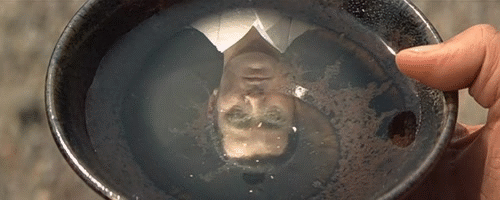
Lord Nakagawa Sadano is making a round of visits with his entourage. One of his attendants, Kannai (Nakamura Kan'emon), takes a cup of tea. In the cup, he sees the face of a man, where none is behind or above him. He empties the cup, and grabs another one. When you have to hydrate, you have to hydrate. And the face in the cup agrees. Kannai empties the cup again, and smashes it this time. He grabs another cup and fills it with tea, but NOPE. THERE HE IS AGAIN! But again...when a guy’s gotta hydrate...

So, yeah, Kannai drinks the tea with the face in it, which I’m sure can only lead to good things. He goes inside the temple, and is directed to assume night watch duties, guarding Sadano. He mutters some prayers to himself, and then spies a cup. Still shaken by the previous incident, he knocks over the cup.

Ah. Well, fuck. The guy’s name is Heinai Shibuku (Noboru Nakaya), and he questions why Kannai doesn’t recognize him. Eventually, he realizes that they’re one and the same, but he doesn’t admit it. Instead, the attendant asks how Shibuku got into the estate, which he doesn’t say. Instead, he claims that the attendant caused him great harm that morning, which I assume was by drinking him. Fair enough, really.
Kannai tries to attack him, but each attack phases through the mysterious stranger, as if he were a ghost or something. Weird, right? Kannai agrees, and he rouses all of the other guards to help find him. However, they all basically call him crazy and take off, leaving him alone.
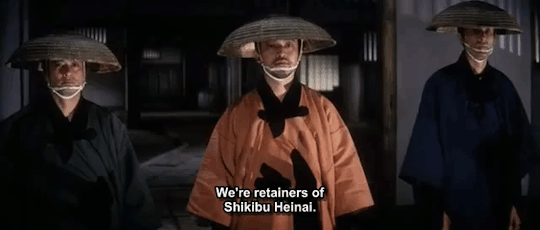
The next night, Kannai’s alone in his chambers, and a young woman comes to visit him. He stares at the cup she’s brought suspiciously (understandably), when he’s also interrupted by news that he has three visitors. He goes to greet them, and they tell him the news that Shibuku was hurt by his sword slashes, and has gone to heal himself. Kannai apologizes for this, but isn’t happy to hear that Shibuku will return on the 16th of EVERY MONTH to avenge himself.
Kannai slashes at the visitors, but they appear to be like Shibuku, and disappear at his every hit and slash, only to reappear elsewhere. Kannai, clearly a little stressed out at this point, continues his assault. And there’s a BRILLIANTLY shot scene, where you see their shadows, and not the samurai themselves. Holy shit, that looks cool.

But then, Kannai appears to get the upper hand, and appears to kill the trio. However, of course, they come back. And Kannai...Kannai’s not doing great at this point. Mentally, I mean. He starts laughing like a maniac, clearly not OK. And then...

That’s it. The story ends. We come back to the modern day, where a woman is trying to find the author, who’s suddenly gone missing after writing all day. His publisher (Nakamura Ganjirō II) comes to visit, and the two search for him. The publisher stumbles upon the story he was writing, which finishes with the idea that, since there’s no ending...why don’t you come up with the best one. How would end a story about a man who swallows another man’s soul?
Maybe...like this.

Holy shit, that’s the author! Now THAT is how you end a fuckin’ ghost story! That was Kwaidan! AND HOT DAMN, that was a good movie! Seriously, I have goosebumps. Review should be interesting. See you there!
#kwaidan#怪談#masaki kobayashi#In a Cup of Tea#茶碗の中#Chawan no Naka#Haruko Sugimura#Osamu Takizawa#Nakamura Kan'emon#Nakamura Ganjirō II#Noboru Nakaya#Seiji Miyaguchi#Kei Satō#fantasy march#user365#365 movie challenge#365 movies 365 days#365 Days 365 Movies#365 movies a year#mygifs#my gifs
8 notes
·
View notes
Text
KWAIDAN (1964) – Episode 118 – Decades of Horror: The Classic Era
"You promised that night you'd never tell anybody. You finally broke the promise. It was a pledge for life for both of us. I told you if you broke it, I would kill you. You betrayed me!" Isn’t that always the way it goes? Join this episode’s Grue-Crew - Whitney Collazo, Chad Hunt, Daphne Monary-Ernsdorff, and Jeff Mohr - as they are mesmerized by the legendary Kwaidan (1968)!
Decades of Horror: The Classic Era Episode 118 – Kwaidan (1964)
Join the Crew on the Gruesome Magazine YouTube channel! Subscribe today! And click the alert to get notified of new content! https://youtube.com/gruesomemagazine
ANNOUNCEMENT Decades of Horror The Classic Era is partnering with PlayNow Media's THE CLASSIC SCI-FI MOVIE CHANNEL, THE CLASSIC HORROR MOVIE CHANNEL, and WICKED HORROR TV CHANNEL, which all now include video episodes of The Classic Era! Available on Roku, AppleTV, Amazon FireTV, AndroidTV, Online Website. Across All OTT platforms, as well as mobile, tablet, and desktop. https://classicscifichannel.com/
This film contains four distinct, separate stories: 1) "Black Hair": A poor samurai who divorces his true love to marry for money, but finds the marriage disastrous and returns to his old wife, only to discover something eerie about her; 2) "The Woman in the Snow": Stranded in a snowstorm, a woodcutter meets an icy spirit in the form of a woman who spares his life on the condition that he never tells anyone about her. A decade later he forgets his promise; 3) "Hoichi the Earless": Hoichi is a blind musician, living in a monastery who sings so well that a ghostly imperial court commands him to perform the epic ballad of their death battle for them. But the ghosts are draining away his life, and the monks set out to protect him by writing a holy mantra over his body to make him invisible to the ghosts. But they've forgotten something; 4) "In a Cup of Tea": a writer tells the story of a man who keeps seeing a mysterious face reflected in his cup of tea.
IMDb
Director: Masaki Kobayashi
Writer: Yôko Mizuki (screenplay); Lafcadio Hearn (stories, as Yakumo Koizumi)
Music: Tôru Takemitsu
Cinematography: Yoshio Miyajima
Film Editing: Hisashi Sagara
Art Direction: Shigemasa Toda
Set Decoration: Dai Arakawa
Costume Design: Masahiro Katô
Musician: Kinji Tsuruta (biwa)
Cast
"Kurokami" ("Black Hair")
Michiyo Aratama as First wife
Misako Watanabe as Second Wife
Rentarō Mikuni as Husband
Kenjiro Ishiyama as Father
Ranko Akagi as Mother
"Yuki-Onna" ("The Woman of the Snow," "Snow-Woman")
Tatsuya Nakadai as Minokichi
Keiko Kishi as the Yuki-Onna
Yūko Mochizuki as Minokichi's mother
Kin Sugai as Village woman
Noriko Sengoku as Village woman
"Miminashi Hōichi no Hanashi," ("Hoichi the Earless")
Katsuo Nakamura as Hoichi
Tetsurō Tanba as Warrior
Takashi Shimura as Head priest
Yoichi Hayashi as Minamoto no Yoshitsune
Kazuo Kitamura as Taira no Tomomori
Yōsuke Kondō as Benkei
"Chawan no naka" ("In a Cup of Tea")
Haruko Sugimura as Madame
Osamu Takizawa as Author / Narrator
Ganjirō Nakamura as Publisher
Noboru Nakaya as Shikibu Heinai
Seiji Miyaguchi as Old man
Kei Satō as Ghost samurai
Kwaidan is Daphne’s pick and she loves every single second of the 183-minute runtime. In fact, she watched it three times! The beauty of the film, the amazing storytelling, and both the sound and set design blew her away. Chad agrees that it is a beautiful film with wonderful sets and music and appreciates how the four segments are based on supernatural folk tales. For the record, his favorite of the four is “The Woman of the Snow.” As a big lover of world folklore and ghost stories, Whitney is also on the Kwaidan bandwagon, granting it everything anyone could want in finely detailed sets, makeup, and folklore. The middle two stories, “The Woman of the Snow” and “Hoichi the Earless,” grabbed her the most. Jeff is gobsmacked by Kwaiden, calling it a stunningly beautiful film. He loved all the stories but “Hoichi the Earless” is his favorite with its historical prologue.
If you haven’t seen Kwaidan, the Classic Era Grue-Crew strongly recommends it. Yes, three hours is a long slog, but the individual stories are completely separate, so you can digest it a piece at a time. So if you haven’t seen it, do it know. If you have seen it, watch it again! Don’t make them break their feet off in your ass! At the time of this writing, Kwaidan is available to stream on The Criterion Channel and HBOmax, and on physical media as a Blu-ray disc from Criterion.
Gruesome Magazine’s Decades of Horror: The Classic Era records a new episode every two weeks. Up next on their very flexible schedule is one chosen by Whitney: Dos Monjes (1934, Two Monks) directed by Juan Bustillo Oro. Dos Monjes is available to stream on YouTube and on physical media in “Martin Scorsese's World Cinema Project No. 3” (The Criterion Collection) [Blu-ray]. And the world folklore just keeps on coming!!
Please let them know how they’re doing! They want to hear from you – the coolest, grooviest fans: leave them a message or leave a comment on the site or email the Decades of Horror: The Classic Era podcast hosts at [email protected]
To each of you from each of us, “Thank you so much for listening!”
Check out this episode!
0 notes
Photo

お茶碗をお貸ししたソムリエ茶人の上田さん(@hiroyaueda )が、日頃よりお使いいただいているとのこと。使いやすいといいんですが(^_^;) 連絡を頂いた方に限りお茶碗をお貸ししてます‼DMにてお知らせください(о´∀`о) #amazing #art #beautiful #japan #culture #ceramic #ceramics #pottery #和 #stoneware #matcha #chawan #chanoyu #sadou #zen #禅 #ソムリエ #日本文化 #アート #陶芸 #陶器 #茶碗 #茶の湯 #抹茶 #茶道 #中目黒 #空 #裏千家 #craft #teaceremony (Naka-Meguro Station)
#chanoyu#茶碗#ceramic#日本文化#中目黒#amazing#japan#art#stoneware#chawan#禅#culture#matcha#teaceremony#ソムリエ#茶道#craft#和#陶器#空#アート#ceramics#zen#pottery#陶芸#sadou#裏千家#茶の湯#抹茶#beautiful
15 notes
·
View notes
Text
As year by year, we are getting more conscious about food ,culture and heritage.Every cuisine get affected by its history ,evolution and religion.Japanese cuisine ,a cuisine stringed by its culture ,social and economics changes happened in past.Japanese cuisine is heavily dependent on seafood products and having largest market of whale meat.
Japan cuisine (washoku) depends on rice with miso soup and different dishes; there is an accentuation on occasional fixings. Side dishes regularly comprise of fish, salted vegetables, and vegetables cooked in juices. Aside from rice, staples incorporate noodles, for example, soba and udon. Japan likewise has many stewed dishes, for example, angle items in stock called oden, or hamburger in sukiyaki and nikujaga. Fish is normal, regularly flame broiled, yet additionally served crude as sashimi or in sushi. Fish and vegetables are additionally rotisserie in a light player, as tempura. Dishes propelled by remote nourishment—specifically Chinese dishes like ramen, seared dumplings, and gyōza—and in addition dishes like spaghetti, curry, and ground sirloin sandwiches have turned out to be embraced with variations for Japanese tastes and fixings.
The culinary items are grains, vegetables or ocean growth, poultry, and red meat .Japanese food is set up with small cooking oil expecting some of southern style dishes. Japanese sustenance is normally prepared with a blend of dashi, soy sauce, purpose and mirin, vinegar, sugar, and salt, ginger and takanotsume red pepper.A unobtrusive number of herbs and flavors might be utilized amid cooking as an indication or complement, or as a methods for killing fishy or tough scents present.some different fixings aresprig of mitsuba or a bit of yuzu skin, a touch of wasabi and ground daikon, Minced shiso leaves and myoga filled in as yakomi, kelp as folded nori or chips of aonori.
Rice is served in its own little bowl (chawan), and each course thing is put without anyone else little plate (sara) or bowl (hachi) for every individual portion.The little rice bowl or chawan (lit. “tea bowl”) serves as a word for the substantial tea bowls in tea ceremonies.Japanese feast would be expedited serving napkins called zen.Before eating, most eating places give either a hot or frosty towel or a plastic-wrapped wet napkin (o-shibori).The rice or the soup is gobbled by grabbing the bowl with the left hand and utilizing chopsticks (hashi) with the right, or the other way around in the event that one is left-handed.The appropriate use of chopsticks (hashi) is the most imperative table manners in Japan.It is traditional to eat rice to the last grain.
Meal of Japanese cuisine
yakimono(grilled and pan-fried dishes ),
nimono (stewed/simmered/cooked/boiled dishes ),
itamemono (stir-fried dishes ),
mushimono (steamed dishes),
agemono(deep-fried dishes ),
sashimi(sliced raw fish ),
suimono and shirumono (soups),
tsukemono(pickled/salted vegetables),
aemono(dishes dressed with various kinds of sauce),
su-no-mono(vinegared dishes),
chinmi (delicacies, food of delicate flavor )
Kaseki
Kaiseki is a type of art form that balances the taste, texture, appearance, and colors of food.It comprised a bowl of miso soup, include an appetizer, sashimi, a simmered dish, a grilled dish, and a steamed course with additional dishes:
Sakizuke : an appetizer similar to the French amuse-bouche
Hassun : one kind of sushi and several smaller side dishes.
Mukōzuke : a sliced dish of seasonal sashimi.
Takiawase : vegetables served with meat, fish or tofu; simmered separately.
Futamono : a “lidded dish”; typically a soup.
Yakimono : (1) flame-grilled food (esp. fish); (2) earthenware, pottery, china.
Su-zakana : a small dish used to clean the palate, such as vegetables in vinegar.
Hiyashi-bachi : served only in summer; chilled, lightly cooked vegetables.
Naka-choko : another palate-cleanser; may be a light, acidic soup.
Shiizakana : a substantial dish, such as a hot pot.
Gohan : a rice dish made with seasonal ingredients.
Kō no mono : seasonal pickled vegetables.
Tome-wan : a miso-based or vegetable soup served with rice.
Mizumono :a seasonal dessert; may be fruit, confection, ice cream, or cake.
Rice and noodles
Gohan and Meshi are the name used for cooked rice.Rice is short-grained and becomes sticky when cooked. Hakumai is very popular among them.Unpolished brown rice is getting popularity in japan.
Sweets
Wagashi is Japanese traditional sweet made up of red bean paste and mochi.Green tea flavored ice cream is also popular among them. Kakigōri and dorayaki is a ice based dessert flavored with syrup or condensed milk.
Beverages
SANTA ROSA, CA – FEBRUARY 07: A Russian River Brewing Company customer takes a sip of the newly released Pliny the Younger triple IPA beer on February 7, 2014 in Santa Rosa, California. Hundreds of people lined up hours before the opening of Russian River Brewing Co. to taste the 10th annual release of the wildly popular Pliny the Younger triple IPA beer that will only be available on tap from February 7th through February 20th. Craft beer aficionados rank Pliny the Younger as one of the top beers in the world. The craft beer sector of the beverage industry has grown from being a niche market into a fast growing 12 billion dollar business, as global breweries continue to purchase smaller regional craft breweries such this week’s purchase of New York’s Blue Point Brewing by AB Inbev. (Photo by Justin Sullivan/Getty Images)
Green tea may be served to most Japanese dishes.Japan are pale-colored light lagers, with an alcohol strength of around 5.0% ABV. Sake is a brewed rice beverage that typically contains 15%–17% alcohol and is made by multiple fermentation of rice. Shōchū is a distilled spirit that is typically made from barley, sweet potato, buckwheat, or rice.Total market share of wine on alcoholic beverages is about 3%.
Japanese cuisine and health
Dishes consist of grains and vegetables, with moderate amounts of animal products and soy but minimal dairy and fruit – had a reduced risk of dying early and from heart disease or stroke.Japan have lowest rates of obesity.It have highest number of centenarian of the world possess lowest rate of age related disease.This also includes phytoestrogens, or plant-based oestrogens, that may help protect against hormone-dependent cancers, such as breast cancer.They have a traditional saying, “hara hachi bu”, which means to eat until you are 80% full, and they start teaching it to their children from a young age.
“Eat to live don’t live to eat”
“Hara Hachi Bu”
Japanese cuisine: A traditional and culture cuisine As year by year, we are getting more conscious about food ,culture and heritage.Every cuisine get affected by its history ,evolution and religion.Japanese cuisine ,a cuisine stringed by its culture ,social and economics changes happened in past.Japanese cuisine is heavily dependent on seafood products and having largest market of whale meat.
0 notes
Photo

June 30, 2017
Kwaidan (1965)
“Taking its title from an archaic Japanese word meaning ‘ghost story,’ this anthology adapts four folk tales. A penniless samurai marries for money with tragic results. A man stranded in a blizzard is saved by Yuki the Snow Maiden, but his rescue comes at a cost. Blind musician Hoichi is forced to perform for an audience of ghosts. An author relates the story of a samurai who sees another warrior’s reflection in his teacup.”
Genre: Horror
Where: Shudder
Comments: The cinematography in this film is breathtaking. I loved all the stories the same but for different reasons. 'Kurokami’ was a great tale of revenge. 'Yukionna’ was sad and visually stunning while 'Miminashi Hōichi no Hanashi’ was wonderfully bizarre and funny. Ears. 'Chawan no Naka’ was downright terrifying. I love anthologies that incorporate themes and, although vastly different from one other, these four stories evoke different emotions that compliment the previous work and together they make this film feel complete.
Rating: 5/5
0 notes
Text
The Chanoyu Hyaku-shu [茶湯百首], Part III: Poem 54.

〽 Koicha ni ha yu kagen atsuku fuku ha nao awa naki-yō ni katamari mo naku
[濃茶には湯加減熱く服は尙 泡無き樣にカタマリも無く].
“With respect to koicha, the water should be hot, and the portion free of foam; and also there should be no katamari.”

Yu kagen atsuku [湯加減熱く]: kagen [加減] means the state or condition (of the hot water). Fuku ha nao awa naki-yō [服は尙泡無き樣]: fuku [服] refers to a dose or portion (of medicine)¹, so fuku ha nao [服は尙] means “furthermore, the portion (should be)...;” awa naki-yō [泡無き樣] means free of foam.
Koicha does not develop a frothy head of foam the way usucha does, so the scattering of small bubbles (which appear distinctly white against the dark green of the tea) might visually suggest some sort of impurity or contamination².
Katamari [カタマリ = 固まり] means a lump. After transferring the matcha into the chawan, the host takes the chashaku and smooths out the tea. At this time, the host was also supposed to break up any apparent lumps, since they can easily turn into katamari when hot water is added³.

This poem is not represented in every collection of the Chanoyu hyaku shu⁴; but in those where it is found, the wording is always the same.
_________________________
¹This traditional usage may derive from the fact that tea was originally considered a medicine.
While the modern schools hold that this is because only one bowl of koicha is prepared, to then be shared by all of the guests, this practice (called sui-cha [吸い茶]) was not really employed by Jōō or Rikyū*, both of whom served koicha in individual portions (or, in the case of Rikyū, did so for the shōkyaku, while asking the other guests share a bowl with their neighbor, in order to save time). ___________ *According to Rikyū’s own writings -- and in contrast to the arguments put forward by the modern schools (who ascribe the origin of the practice to Shukō) -- the practice of sui-cha began in Uji, during the annual auction of the year’s new tea leaves (at the end of the harvest, after the leaves had been processed). Since each bowl of koicha can be subtly different from the next, even when all other conditions are equal, it was decided that a single bowl of koicha would be prepared, and quickly shared by all the bidders, so they would all have a clear and equal understanding of the characteristics of that particular tea (since this would inform the amount of money that they were willing to bid for the lot -- usually the leaves were purchased by tea merchants, who would take them back and blend them with others to produce that firm’s characteristic flavors, after which they were sealed in jars and stored carefully until the beginning of winter).
Certain of his contemporaries began to adopt the custom, employing it during their own chakai, but Rikyū felt it was inappropriate. He held that the shōkyaku should always be served individually (since the gathering was effectively given for him -- so he should be allowed to enjoy his koicha without being forced to worry about leaving sufficient tea for the others), while the others might share bowls in groups of two (it being not too difficult to drink half).
In the wabi setting, he held that sui-cha would only be appropriate on the occasion of the kuchi-kiri no chakai [口切茶會], when the jar of new tea was cut open for the first time, since time would not permit the host to grind a sufficient quantity of matcha so that it could be served as usual. On such occasions, since the jar was cut open at the beginning of the shoza, only the tea that could be ground by the time of the naka-dachi would be available, so Rikyū prepared it as a single bowl of rather thin koicha, which all of the guests would share.
²Traditionally this is explained as looking as if poison* had been mixed with the matcha (with the poison failing to dissolve completely during the blending process); but the more likely explanation is that it would look like dust had fallen onto the koicha (such as from the host’s sleeve, as he withdrew the chasen) as the blending process was concluding. ___________ *Which is argued to have been the preferred way of eliminating the opposition by followers of the despised and feared Ikkō-shū. The problem with this line of argument is that both Jōō and Rikyū (and virtually all of their contemporaries, Japanese as well as the Korean’s of Sakai and Hakata) were followers of the Ikkō-ichi-nen Shū [一向一念宗], apparently having trained as a de facto novice for a certain period of time in their youth. Thus it is not likely that Jōō or Rikyū would have facilitated the dissemination of what could have been taken to be anti-Ikkō-shū propaganda.
³A katamari begins as a lump in the matcha (often because the tea remained too long in the chaire that it began to be affected by atmospheric moisture). What happens is that the outside of the lump absorbs water, while the interior remains relatively dry. Rather than breaking down when the tea is blended with the chasen, the katamari remains intact, becoming quite gummy in the process.
Katamari are very unpleasant for the guests to drink -- disquieting enough that they will completely destroy the guest’s pleasure when drinking the koicha*. ___________ *While this word is introduced in a discussion of koicha, katamari can also occur in usucha, and are just as insidious in that context. This is why the matcha should always be sifted using a cha-furui [茶篩] (a specially designed tea-sieve -- since something like a juice strainer may not have the wires close enough together to prevent minute katamari from sifting through) prior to use -- whether the tea will be put into a chaire or natsume, or simply used to prepare a bowl of tea tate-dashi.
⁴Including Jōō’s original collection (that was preserved in the Matsu-ya family archives), and Rikyū’s 1580 version.
This poem’s absence from the earliest manuscripts suggests that it was written by someone other than Jōō or Rikyū (possibly Hosokawa Sansai, since it is found in the collection associated with him, as well as the Sen family, which was relying on Sansai to fill in many of the details of their understanding of Rikyū and his ideas about chanoyu), and added to the collection -- perhaps in the interests of filling what was perceived to be an omission* that later generations felt was essential advice that needed to be passed on to the beginner in as authoritative a way† as possible. ___________ *The reader has to bear in mind that the way chanoyu was learned changed drastically between the mid-sixteenth century and the mid-seventeenth century (when all of the versions that did not come directly from Jōō and Rikyū were assembled).
In the sixteenth century, a person interested in chanoyu began by applying to join a tea group (usually one that had coalesced around one of the popular tea masters of the day -- with the master acting more as a living repository of knowledge, tradition, and precedent, while the actual work of teaching was delegated to his principal disciples). The beginner, once accepted, began participating in the group’s monthly or bimonthly chakai as a middling guest (where his primary responsibility was to watch the goings on quietly and with composure). Only after several years of this was the novice invited to learn the procedures (something that could be accomplished rather easily and quickly, since he was already thoroughly familiar with most of what he would learn in the context of the actual chakai). Thus the learning phase lasted no more than several months at most -- after which the novice began to host his own chakai for the group (receiving invaluable criticism after each).
During the seventeenth century, the modern system (where the student pays the teacher for lessons) began to make its appearance -- in this setting, the beginner usually had very little knowledge of, or experience with, chanoyu when he presented himself at the teacher’s kyōshitsu [教室] for his first lesson. As a result, matters that had formerly been obvious now needed to be explained, and explained in detail; and it was in this situation that the majority of the spurious poems were added to the collection -- in order to give an authoritative voice (no matter how false) to those arguments that the Sen family (and other leaders) felt needed to be emphasized, but which had not been addressed in earlier times.
†In other words, by putting the words into Rikyū’s mouth (since, by mid-century, the poems were already considered to have been exclusively Rikyū’s productions -- this was, in part, what inspired Katagiri Sadamasa to investigate Jōō’s own hand in the composition of the poems, which is how they became part of the Sekishū canon as well).
==============================================
◎ If these translations are valuable to you, please consider donating to support this work. Donations from the readers are the only source of income for the translator.
To contribute, please use the following link:
https://PayPal.Me/chanoyutowa
0 notes
Text
Nampō Roku, Book 7 (63): Rikyū’s Ji-butsu-dō [持佛堂].

63) Concerning [Ri]kyū’s ji-butsu-dō [持佛堂], to the east of the katte [勝手] attached to his two-mat tearoom, another two-mat room was [erected]¹. This [two-mat room] was surrounded, on three sides, by roofed verandas; and in the toko at the head of the room, [the image of his] “personal Buddha” was [installed]².
On the memorial days, when [Rikyū’s] thoughts turned to [his ancestors] and he performed a memorial service, invariably oshō [和尚], accompanied by this monk, were always invited to attend³. Inside the ji-butsu[-dō] the small utensils [= the chaire and temmoku-chawan] were of an even number; and these [utensils] were displayed on yin-kane. (If [you] asked [him] why [it was only the small utensils that were arranged on yin-kane], [Rikyū] would have replied that more than this was unnecessary [to cause the arrangement to be yin, as was appropriate when offering tea in memory of the departed]⁴.)
On one occasion, on the day of Sen’ami’s memorial service, [Rikyū] prepared tea using [his] small nasubi [chaire]: the chaire was displayed as an yin hitotsu-mono [一物]⁵.
_________________________
◎ According to Tanaka Senshō’s commentary, the description given here resembles the several Sen families’ Rikyū-dō [利休堂]* -- their memorial shrines to Rikyū as the ancestor of their families. As the language of this entry is likewise of the second half of the seventeenth century, this was probably another instance where an attempt was being made to validate these constructions by making it seem that Rikyū had used a similar sort of shrine to venerate his ancestors. This is also one of the few actual documents where the mysterious Sen’ami [千阿彌]† is named as the ancestor of the family.
Tanaka laments the fact that no drawing has come down to us to inform us of the room’s actual appearance -- as would have been expected given the rather vague description provided by the text.
It is important to point out that the Tokugawa bakufu wished to encourage the worship of the ancestors -- particularly those individuals who had been instrumental in their rise to power -- so it is probably in this vein that this entry was added to the collection. ___________ *The description given in this entry makes it difficult to associate this construction with any of Rikyū’s known residences. Since Rikyū always had the guests’ entrance on the north side of the tearoom, in a room where the guests’ entrance was in the same wall adjoined by the mukō-ro (the 2-mat rooms with a geza-toko [下座床]), this would place the ji-butsu-dō next to the wall behind the guests’ seats (which would impede the light entering through the important windows behind their backs); if it is referring to the Mozuno ko-yashiki (as most documents from the Edo period that can be clearly sited do), this would place the ji-butsu-dō beside the tearoom’s mizuya-veranda. Now while that is not inherently impractical -- especially since it seems that the ji-butsu-dō did not have its own attached katte -- it would obstruct the light entering the room from that side (the Mozuno ko-yashiki had a shōji panel as the door of the dōko, the intention of which was to allow light to enter at floor level; and if a building was constructed next to the mizuya), at least unless there was so much space between the two that the mizuya would not really provide any support to the ji-butsu-dō.
The fact that there was no katte, however, makes this room appear similar to the Mozuno ko-yashiki, however, because in that room, too, the host entered from the veranda (on which the guests sat during the naka-dachi).
The modern versions of the Rikyū-dō (usually referred to as sō-dō [祖堂], ancestor shrines) present in the several Sen family compounds have been rebuilt several times since the seventeenth century, and so their present iterations may not reflect their original shapes or configurations (indeed, they all seem to have been reimagined as places where a larger number of people could be seated, most of whom would be spectators to the act of offering of tea).
†This name indicates that he was an adherent to the Amidist sect from which chanoyu itself sprang; and he is purported to have been a member of the dōbō-shū [同朋衆] (though his name does not seem to be mentioned in this, or any other, capacity in any of the accounts from the Ashikaga period). Still, while he may not have served in Japan, as that system of high ranking governmental advisers providing a sort of cultural education to the ruler imitated the hwa-rang-do [화랑도 = 花郎道 or 花郎徒] of the Goryeo dynasty, it is possible that this person served in such a capacity in the court there, and that his memory was brought back from the continent by Rikyū, who chose to recognize him as the familial patriarch by taking the surname Sen [千] (which is a Korean family name, rather than a Japanese surname) as his own when he returned to Japan.
¹Kyū no ji-butsu-dō ha, ni-jō-shiki no cha-seki no katte yori, higashi no kata ni mata ni-jō-shiki ni shite [休ノ持佛堂ハ、二疊鋪ノ茶席ノ勝手ヨリ、東ノ方ニ又二疊敷ニシテ].
Ji-butsu-dō [持佛堂] is a dedicated room (often constructed as a separate building attached to the residence by a hallway or veranda) in a private residence in which a statue of the household’s “personal Buddha,” and the memorial tablets of their deceased members, are kept. It functions as a private oratory; and it is there that offerings to the ancestors (such as during New Year’s, and the O-bon festival) are made.
Ni-jō-shiki no cha-seki no katte yori, higashi no kata ni mata ni-jō-shiki ni shite [二疊敷の茶席の勝手より、東の方に又二疊敷にして] means “from the katte of the 2-mat tearoom, on the east side there was another 2-mat room.”
This 2-mat room would have been the ji-butsu-dō [持佛堂].
Since Rikyū preferred to have the guests’ entrance on the north side of the tearoom, and since his earlier 2-mat rooms were configured with a geza-toko [下座床]*, with the mukō-ro cut near the guests’ entrance, this means that the katte would have had to be either on the south or west side of the room, as shown below.
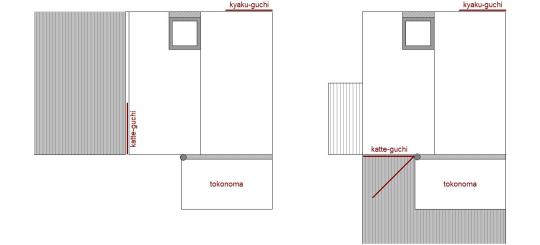
Because the tearoom itself is to the east of the katte in Rikyū’s earlier rooms (on the left), this text could not be referring to this kind of room.
In the case of the room shown on the right, which was the sort of 2-mat room (with a hinged katte-guchi, that imitated that door originally proposed for the 1.5-mat room) that was erected in Rikyū’s residence in Kyōto, the problem is that to the east of the 6-mat katte was Rikyū’s 18-mat reception room (with 2-mat jō-dan) -- according to surviving records of this room on which the below sketch is based†. While some versions of this drawing show a single shōji in the wall perpendicular to the dōko in the katte (though with no mention of what lay beyond that door), if the veranda that surrounded the ji-butsu-dō on three sides adjoined the katte there, the ji-butsu-dō would be east of the 2-mat room, not its katte -- and such a construction would probably impact the lighting within the tearoom itself‡.
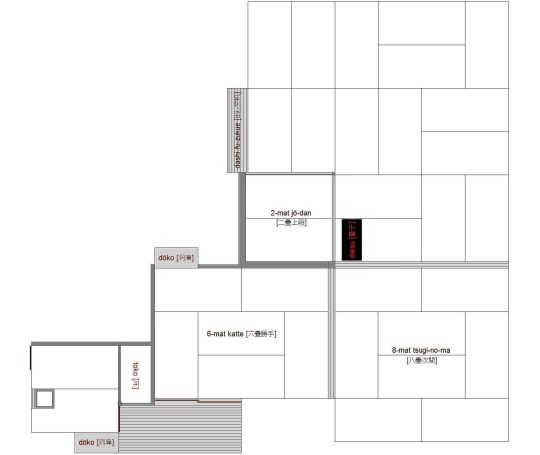
As for the Mozuno ko-yashiki, Rikyū’s final 2-mat room, it had a mizuya-dōko [水屋洞庫], and so did not have a katte at all.
In light of these details, it is difficult to understand the logistics from this description. __________ *A geza-toko [下座床], which had been Rikyū's preferred orientation for the toko in his small rooms since the creation of his 2-mat daime Jissō-an [實相庵] in 1555, is a toko located on the guests’ left, and so at the foot of the room (if the location of the mukō-ro is the upper side).
The 1.5-mat room (which was created not long after the 2-mat daime room) also featured a geza-toko -- though he quickly abandoned it since it was too difficult for the guests to use).
The geza-toko arrangement, regardless of the size of the room, allows the host to face the shōkyaku simply by turning toward his right. This enables him to offer the bowl of tea directly to that guest -- which may have been a large part of the reason for his favoring that orientation.
†It seems that Rikyū preferred to connect his 2-mat rooms to the main building, while it was the 4.5-mat room that was detached. The reason appears to have been because this allowed the guests to be served the kaiseki in the 6-mat katte; and at the conclusion of the gathering they would be able to walk directly into the shoin (which would have been an important detail when serving people such as Hideyoshi).
‡Several different representations of Rikyū’s residence within Hideyoshi’s Jurakudai [聚樂第] compound have come down to us. The above floor-plan is based on the only one that shows how the 2-mat room was connected to its katte, and, ultimately, to the 18-mat “colored shoin” -- though none of the drawings indicate the presence of a ji-butsu-dō anywhere on the grounds (admittedly, they only focus on showing the arrangement of the main buildings within the compound).
In one version of this sketch that is held by the Sen family (and on which Omotesenke’s reconstruction of the “colored shoin” is said to have been based), any reference to the 2-mat room is completely missing (and a notation on that document indicates that, rather than the pair of shōji that lead to the 2-mat room, a kuguri [クヽリ] -- presumably a nijiri-guchi or other low entrance of that sort -- was found in that place). While many of the other details of the six-mat room are the same, it is not named as a katte (probably since, without the tearoom, there is no other room to which it could serve as this appendage).
²San-bō ni hisashi wo mawashi, shōmen ni toko, ji-butsu ari-shi nari [三方ニヒサシヲマハシ、正面ニ床、持佛アリシ也].
San-bō ni hisashi wo mawashi [三方に庇を廻し]: hisashi [庇] means either an aisle room (a narrow room that encircles one or more sides of the main room, which allows servants and functionaries to move around without disturbing the people seated within the main room), with the outer sides facing the gardens -- with or without shōji or latticed shutters (shitomi-do [蔀戸]) to protect the interior from the weather, or its occupants from being spied upon); or, as here, a simple veranda protected by an overhanging roof (sometimes with a low balustrade standing at the outer edge).
San-bō ni [三方に] means that the hisashi were found on three sides of the central room*.
Shōmen ni toko [正面に床]: shōmen ni [正面に]† means directly, head-on -- that is, the toko was located at the deepest part of the room -- so the room was oriented like the Mozuno ko-yashiki, with the recess at the far end of the room. The hisashi (likely separated from the interior of this 2-mat room by three banks of shōji) surrounded the room on the other three sides. This is the arrangement shown below (the dimensions of the three hisashi are, of course, pure speculation).
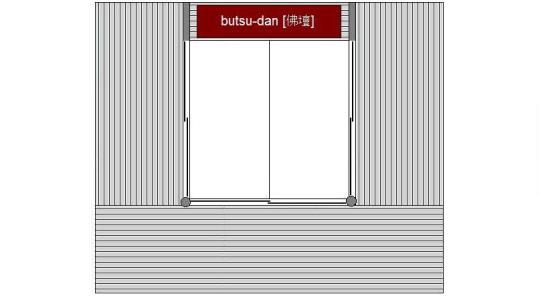
Ji-butsu ari-shi nari [正面に床、持佛ありしなり]: ji-butsu [持佛] means a personal image of the Buddha, one’s own Buddha statue. In other words, an image of the Buddha‡ was installed in the toko (probably resting on some sort of butsu-dan [佛壇], a Buddhist altar** -- together with an incense burner, a kōgō, one or a pair of candlesticks, and one or two small flower arrangements) -- along with the name-tablets of deceased members of the family. Possibly a kinran or brocade altar-cloth would have been spread underneath the censer, with a valance and curtains (suspended from the otoshi-gake [落し掛]) surrounding the butsu-dan on three sides.
Shibayama's version provides the reader with a little more clarity: san-bō ni hisashi tsuke-mawashi, shōmen ni toko ji-butsu wo kamaetaru jūkyo nari [三方ニヒサシツケ廻シ、正面ニ床持佛ヲ構ヘタル住居也].
San-bō ni hisashi tsuke-mawashi [三方に庇付け廻シ] means on three sides hisashi were attached around (the two-mat room's) periphery.
Shōmen ni toko ji-butsu wo kamaetaru jūkyo nari [正面に床持佛を構えたる住居なり] means a dwelling (or residence)†† in the forward part of which the ji-butsu (i.e., the butsu-dan [佛壇]) was enclosed within the toko.
That is, the butsu-dan on which the image and ancestral tablets were displayed was enclosed within the tokonoma. __________ *Tanaka Senshō, however, argues that buildings of this sort generally have hisashi on all four sides, which provide seating for various people who are participating (in an inferior capacity) in the ritual. Only the principal descendant of the departed, and the monks who were chanting the prayers, would enter the ji-butsu-dō.
†Presumably, shōmen [正面] means the side of the room that functioned as its focal point.
‡Today this would invariably be Shakyamuni (Siddhārtha Gautama), but the idea of ji-butsu also allows a representation of the Buddha (or even a Bodhisattva) to which one is particularly devoted -- in the case of most chajin of Rikyū's day, this would have been Amitābha (Amida [阿彌陀]) as the Lord of the Pure Land and the principal Buddha of the Ikkō-ichi-nen-shū [一向一念宗].

Though even Bhaiṣajyaguru (Yaku-shi nyorai [藥師如來]), the Bodhisattva of Healing (shown above) under whose protection chanoyu is included (and who is often depicted holding a small jar, like a chaire, in his left hand).
**While I have shown the butsu-dan extending across the entire width of the room, many of the commentators make the tokonoma 3-shaku, 4-shaku, or 4-shaku 2-sun wide, with the butsu-dan reduced accordingly. Some even envision a circular opening in the wall, covered by a pair of small shōji that open onto a recess wherein the Buddha statue and its accompanying objects were enshrined.
While these various representations imitate what is seen in the Sen families’ sō-dō [祖堂], they would be more appropriate to the Edo period than to Rikyū’s day. Rikyū would probably have used a rather long, somewhat narrow, table that extended across the width of the room (as I have shown) -- based on the way things have traditionally been done, with respect to ancestor-worship altars, in both China and Korea.
††Jūkyo [住居] means a residence or dwelling. Whether this is referring to Rikyū's compound, or to the toko (as the place where the ji-butsu “resides”), is unclear.
³Ekō kokorozashi no kuyō-bi ni ha, kanarazu oshō narabi ni kono-bō wo manekare-shi ni [囘向心ザシノ供養日ニハ、カナラズ和尚幷コノ坊ヲ招カレシニ].
Ekō [回向]* means to hold a memorial service (for a departed person).
Kokorozashi [志]†. Shibayama explains this usage in the following way:
sono seisha ni kokoro wo mukuru i ni te, ki-nen to iu ni onaji‡
[其逝者ニ心ヲ向クル意ニテ、記念ト云フニ如ジ].
“The meaning is to turn one’s thoughts to the deceased; it is the same as saying to commemorate or honor the memory of (someone).”
Kuyo-bi [供養日]: kuyo [供養] is a Buddhist term meaning a memorial service. Kuyo-bi [供養日], then, would name the day of the memorial service.
Kanarazu oshō narabi ni kono-bō wo manekare-shi ni [必ず和尚ならびこの坊を招かれしに] means certainly (kanarazu [必ず]) oshō** [和尚], and also (narabi ni [ならびに]) this monk††, would be invited (manekare-shi [招かれしに]).
In other words, Rikyū had the desire that, as a way to do honor to the deceased, he would always invite ōsho [和尚] and Nambō Sōkei to the memorial service. Apparently with the intention that they chant prayers during the offering of tea at the altar.
Shibayama’s text suggests a slightly different interpretation might be in order: ekō kokorozashi no kuyō-bi ni ha, kanarazu kore ni te oshō narabi ni kono-bō wo manekite cha ari-shi ni [回向志ノ供養日ニハ、必コレニテ和尚幷ニ此坊ヲ招キテ茶アリシニ].
This means on the memorial day on which Rikyū turned his thoughts to the performance of the commemorative service, (he) would certainly invite oshō and this monk for tea on this occasion.
Perhaps he is thinking of hosting a chakai for the two monks after the service is finished (as a way to express his thanks for their presence and prayers)? __________ *Ekō [囘向] uses one of those strange kanji variants that became fashionable during the seventeenth century.
†Kokorozashi [心ざし], as this word is written in the Enkaku-ji text, is the same nonstandard form found in the preceding (and other) entries -- suggesting that they were either written or edited by the same individual or group.
‡Onaji [如じ] is possibly a variant (and non-standard) way of writing the word onaji [同じ]. It is equivalent to gotoshi [如し], meaning “the same as.”
**According to Hisamatsu Shin-ichi [久松真一; 1889 ~ 1980] sensei, the editor of the Sadō ko-ten zen-shū [茶道古典全集] version of the Nampō Roku, the title oshō is referring to Shōrei Sōkin [笑嶺宗訢; 1505? ~ 1584].
However, Hideyoshi's Jurakudai (in which the most likely version of Rikyū’s two-mat room seems to have made its first known appearance) was not completed until 1586. In that case, and assuming that this particular ji-butsu-dō is the one that would have been built somewhere on the grounds of Rikyū's residence there, oshō would more likely refer to Kokei Sōchin 「古溪宗陳; 1532 ~ 1597].
Perhaps it should be added that, while Shibayama Fugen says nothing regarding the supposed identity of this “oshō,” Tanaka Senshō agrees with Hisamatsu sensei’s assessment.
††In other words, Nambō Sōkei.
⁴Ji-butsu no uchi, ko-dōgu in-kazu in-kane nari-shi hodo ni tazune-sōroeba, anagachi ni sono sata ni mo oyobu-bekarazu to ha no tamai-shi nari [持佛ノ内、小道具陰數陰カネナリシホドニ尋候ヘバ、アナガチニ其沙汰ニモ及ベカラズトハノ玉シ也],
Ji-butsu no uchi [持佛の内] means within the ji-butsu-dō.
Ko-dōgu in-kazu in-kane nari-shi [小道具陰數陰カネなりし]: according to the previous entry, ko-dōgu [小道具] refers, in this context, to the chaire and the temmoku. The number of these things should be an even number*, and they should be displayed on yin-kane.
Hodo ni tazune-sōroeba [ほどに尋候えば] means if (you) should ask the reason for this -- in other words, if you should feel inclined to ask about why only the chaire and chawan need to conform to the yin-kane (rather than all of the other utensils).
Anagachi ni sono sata ni mo oyobu-bekarazu to ha no tamai-shi nari [強ちにその沙汰にも及ぶべからずとはの給いしなり]: anagachi ni [強ちに] means (not) necessarily, (not) always; sono sata ni mo [その沙汰にも] means also (when) handling† such things; oyobu-bekarazu [及ぶべからず] means should not go beyond (something), should not exceed (something).
In other words, this is saying that it is not necessary for anything but the chaire and chawan to be associated with a yin-kane in order to achieve a yin arrangement‡. __________ *Meaning that both the chaire and the chawan should be displayed together. Placing out the chaire only (and carrying in the temmoku later), for example, would be a violation of this rule.
†Specifically, deciding what is right -- as opposed to what is wrong -- in a given setting or situation.
‡Preparing tea in memory of a departed person requires a yin arrangement.
Whether the host is using a daisu, or arranging the utensils directly on the mat, the positions of the other utensils -- the furo or (in the case of a 2-mat room) mukō-ro, the mizusashi, and so on, are mostly fixed, and cannot be changed.
⁵Aru-toki Sen’ami no nenki-no-hi ni, ko-nasubi ni te cha-taterareshi ni ha in no hitotsu-mono nari [アルトキ千阿彌ノ年忌日ニ、小ナスビニテ茶立ラレシニハ陰ノ一物也].
Aru-toki Sen'ami no nenki-no-hi ni [ある時千阿彌の年忌日に]: aru-toki [ある時] means on one occasion*; Sen’ami† nonenki-no-hi ni [千阿彌の年忌日に] means on the day of the anniversary of Sen’ami's death.
Ko-nasubi ni te cha-taterareshi [小茄子茶入にて茶立られし] means that Rikyū prepared tea (during the memorial service) using a small nasu-chaire‡.
In no hitotsu-mono [陰の一物] means that Rikyū displayed this chaire so that it was resting squarely on a yin-kane** -- with the implication being that this was done as a gesture of respect (both for Sen’ami, and for the chaire).
Shibayama Fugen's version of the text has aru-toki Sen’ami no nenki-hi ni, ko-nasu ni te cha-taterareshi ni ha, in no hitotsu-mono ni okare-shi nari [或時千阿彌ノ年忌日ニ、小茄子ニテ茶立ラレシニハ、陰ノ一物ニ被置シナリ]. But aside from the minor changes in punctuation, and the final okare-shi [被置し = 置かれし] (this verb only states what is already obvious from context) -- all of which help the reader arrive at the correct understanding -- the basic meaning remains the same. ___________ *The implication being that Rikyū used a different set of utensils on every occasion, or at least changed them frequently enough that the author thought this was worth a mention.
This, of course, fits into the ideas that the bakufu was promoting during the first century of the Edo period. For that matter, so does the idea of venerating ones ancestors -- by constructing a dedicated memorial oratory (sō-dō [祖堂]) of some sort (something that remained fairly common, at least among the middle to upper classes in Japan, until fairly recently).
†Sen’ami [千阿彌] was supposed to have been Rikyū's grandfather (though “grandfather” is often used more loosely to mean progenitor or ancestor, regardless of the actual number of generations that separate said person from the present). While modern Sen family mythology states that he was one of the dōbō [同朋], “companions,” serving the Ashikaga shōgunate, his name does not seem to appear in any of the relevant records from that period.
Since the dōbō-shū seem to imitate a similar sort of system that provided training and advice to the Koryeo kings, and (perhaps more importantly) because Rikyū began to voice this understanding of his ancestry only after he returned to Japan from his stay on the continent, the possibility should be considered that Sen’ami was a functionary of the Koryeo court. (A possibility that most Japanese tea people, at least, would find repulsive -- given the ties between modern day chanoyu and the ultra-nationalist camp that has ruled the Japanese nation since the beginning of the 20th century, and which has been largely responsible for rewriting Japanese history as a repudiation of the archaeological and anthropological studies conducted by western-trained Japanese scholars during the late nineteenth and early twentieth centuries, in both Japan and Korea.)
‡While this seems to be a direct allusion to the preceding entry, and while Rikyū did own a ko-nasu chaire, his chaire measured just over 2-sun in diameter, rather than the 1-sun 5- or 6-bu that was prescribed there.
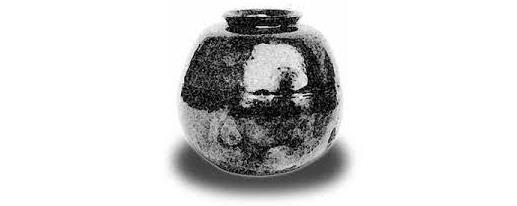
Interestingly, in the Taishō mei-ki kan [大正名器鑑], Takahashi Sōan states that this chaire was the model for Rikyū's small natsume made by Seiami [盛阿彌] (Hideyoshi's principal lacquerer) -- that is, the shape of the lower part of that natsume (up to the point of maximum diameter), as well as its height and diameter, were based on this small nasu-chaire.
**This seems to be an allusion to the mitsu-gumi arrangement that was discussed in the previous entry (though it is unlikely that Rikyū performed that sort of chanoyu in his ji-butsu-dō).
0 notes
Text
March 13, 2021: Kwaidan: Hoichi the Earless (1965)
Um...yeah, no idea, people.

Not sure what “the earless” means, but it worries me. So, rather than try to guess here, let’s get right into it!
This is the third of four tales presented in the film Kwaidan, listed here:
The Black Hair (黒髪, Kurokami)
The Woman of the Snow (雪女, Yukionna)
Hoichi the Earless (耳無し芳一の話, Miminashi Hōichi no Hanashi)
In A Cup of Tea (茶碗の中, Chawan no Naka)
Here we go again! SPOILERS AHEAD!!!
Recap (3/4): Hoichi the Earless

A musician sings a song, known as “The Tale of the Heike”, and is specifically detailing the epic Battle of Dan-no-ura, during which two clans fought each other at the end of a great war. The scene is played out on screen as kabuki theatre, with the singer strumming an instrument in the background of the epic clash. It’s, uh...it’s pretty goddamn rad, not gonna lie to you.
Don’t know if you guys have ever seen kabuki theater, like legit kabuki theater, but it’s genuinely interesting. If you want to see an example accessible to non-Japanese audiences (and nerds like me everywhere), check out Star Wars Kabuki-Kairennosuke and the Three Shining Swords! Here’s a link! It is also rad.

Anyway, the epic tale of war and suicide results in a haunted shoreline, on which the mysterious Heike crabs appear with faces on their shells. But as the story ends, we meet its teller: Hoichi (Katsuo Nakamura), a blind monk who works at a temple. One day, a noise draws him inside one of the buildings of the temple. He attempts to investigate, but finds no one there. Confused, he decides to settle down and play his instrument, the biwa.

But as he does, a soldier (Tetsurō Tamba) appears with a message: his master wishes to see the site of the battle of Dan-no-ura, and also wants to hear Hoichi recite his version of the battle. While Hoichi doesn’t think himself worthy, he still goes along with the mysterious soldier, who takes him...towards the shore. So, dude’s a ghoooooooost, and Hoichi’s also to be fuuuuuuuucked. The soldier takes Hoichi to the beautiful azure temple to see his master.

Yeah, no, it’s definitely haunted, and Hoichi’s either dead, or is about to be dead. Or...wait, is this an Orpheus story? You know, a mortal recording artist so good that even the gods love his hit singles? Dunno, just came to me, so we’ll see. Anyway, he’s brought into the definitely not haunted temple, bedecked in tattered red flags, with beautifully spectral backgrounds all throughout.
Meanwhile, on the shore, a young man is found dead on the shoreline. We don’t see his face...but I have a bad feeling I know who it is. Although, it seems that it might be a fisherman whose boat recently sank...maybe. I’m still not convinced. The other monks wonder where Hoichi’s disappeared to, and then he reappears later that night. OK, cool, he isn’t dead. That warrior from before definitely was, though.
Hoichi never tells the monks where he disappeared to, but he’s soon called back to the mysterious temple by the warrior, who is indeed a ghost. Apparently, they commanded Hoichi not to tell anyone of their meetings, a command which he obeys willingly. Subsequent visits continue, but they obviously start to take a toll on Hoichi, who’s beginning to look, well...gray. Uh oh.

The head monk questions him on his disappearance, but Hoichi makes up an excuse about “needing to finish something, heedless of the hour”. And yeah, he REALLY doesn’t look good. Looks like this one’s gonna be another “don’t fuck with ghosts” lesson, huh? But Hoichi doesn’t really care, as he goes out even in a massive rainstorm. As his fellow monks look for him, he’s playing once again for the ghosts, which includes a child emperor seen in the epic song reenactment seen earlier. So, yeah, these are the spirits lost on the day of the Battle of Dan-no-ura. And those spirits want to hear that song once again.
And, of course, Hoichi plays it for them on the biwa. When ghosts tell you to play a song for them, you goddamn DO IT. We see him play it and the song for them, and all the while, the other monks are looking for him. As they do, will-o-the-wisps appear before them. Which, yeah, is another Pokémon, just saying. Both Gastly and Litwick are basically will-o-the-wisps.

But OK, back to the actual ghost story, as Hoichi plays the biwa with some crazy-ass intensity. As he does, the people he’s playing for change from the emperor and his people to the samurai of the opposing side.
The spirits listen, as we see a painting of the battle and the disaster that came from it. The spirits, ALL of them, listen on, as the scene changes from an attentive spiritual audience, to a battle scene. And, uh...it’s intense. And terrifying. And genuinely very haunting. And while Hoichi can’t see any of it, we can. And again, it is HAUNTING, my lord. And then, as the monks arrive to find Hoichi singing, the spirit court fades away, and Hoichi is instead surrounded by will-o-the-wisps. My God.

The other monks try to take the clearly fucked up Hoichi back to the temple, planning on giving him an exorcism to cleanse him of these spirits. But the spirits, now seen in Hoichi’s absence, all rise as he leaves. Tattered red flags hit water, and the spirits disappear, AND I WILL HAVE NIGHTMARES TONIGHT. Now exposed, Hoichi is spoken to by the head monk, who reveals that doing what a spirit tells you to do is a sure fire way to open yourself up to their influence. And so, a plan is formed, in order to protect Hoichi from further possession. And to do that...it’s time for some painting.

Yeah, the monks paint Buddhist symbols all over Hoichi, hoping to protect him from the spirits influence. And they write ALL OVER him, and it’s both a gorgeous sight, while also being...well, extremely eerie. They paint all over him, in black and red script, even painting his eyelids. The GF pointed out that they’re putting the larger red symbols on his chakras, which makes sense and is neat. They even paint his hair, which is genuinely impressive.
The plan is then formed to let Hoichi outside to act as bait for the spirit to come back. He’s told not to make a sound in front of the spirits, and that he mustn’t move in front of them either. If he does, the spirits will tear him to pieces. But he’s still protected by the Heart Sutra, which is painted all over his body. Except for...his ears. Oh, shit, I think I know what’s gonna happen to poor, sweet Hoichi.

Sure enough, the Spiritual Samurai shows up, and is unable to see every part of him...except for his ears. GODDAMN IT DONKAI (the monk who painted the symbols on him), YOU DUMBASS. Well, the spirit believes that only his ears are left, and the spirit needs proof of Hoichi’s fate...so he takes his ears. And when I say he takes his ears, I mean that HE TAKES HIS FUCKING EARS. HE. RIPS. OFF. HOICHI’S. EARS. And Hoichi doesn’t make a goddamn sound as he bleeds profusely. HOLY FUCKING SHIT DUDE

With that, Hoichi bleeds his way to another part of the temple. Injured, he’s cared for by the head monk and DONKAI, who’ve realized Donkai’s grave mistake. And Hoichi is now Hoichi the Earless. Remind me never to fuck with the spirits without checking EVERY. SINGLE. MINUTE. DETAIL. Hoichi’s basically traded his ears for his life. And the spiritual visitors will no longer visit, according to the head monk. Meanwhile, Hoichi the Earless is now pretty famous, due to his unusual predicament. A wealthy lord wants to meet the strange young man, n as brought along a bunch of people to watch him play. While the monks tell him to refuse the request, he still plays to honor the fallen spirits regardless.
Soon, he and the temple are given money and gifts from all over the place, and Hoichi gains much personal wealth and fame. However, it never was about that for Hoichi, really. He just plays.

And that’s Hoichi the Earless! Wow. Interesting ending. Three out of four! Let’s go to the last, shall we? See you there!
#kwaidan#怪談#masaki kobayashi#hoichi the earless#hoichi-the-earless#Miminashi Hōichi no Hanashi#耳無し芳一の話#Katsuo Nakamura#Tetsurō Tamba#Takashi Shimura#Yoichi Hayashi#Yōsuke Kondō#usermichi#mormarsli#my gifs#mygifs#fantasy march#365 movie challenge#365 movies 365 days#365 Days 365 Movies#365 movies a year#user365
9 notes
·
View notes
Text
March 13, 2021: Kwaidan: The Woman of the Snow (1963)
Y’ever see Interviews with Monster Girls?

Absolutely one of my favorite slice-of-life anime from the past few years, and I genuinely want to rewatch it! Might do so after this, honestly. The conceit of the series is that the main character, a biology teacher named Takahashi, is trying to better understand and help with the issues of the “demi-humans” that attend the school. There’s the vampire girl, Hikari; the dullahan (best character), Kyoko; the math teacher succubus Sakie; and Yuki Kusakabe.
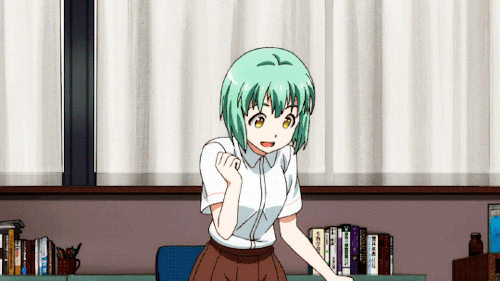
Yuki, as implied by her name is a yuki-onna, also known as a snow-woman. Now in the show, she’s a shy girl who’s always cold, and she’s great. But in mythology, the yuki-onna is...different. A tall woman with long black hair and blue lips, the serene snow woman appears to travelers in blizzards, and freezes them with her icy breath.
While the yuki-onna does have a soft side, she’s best known for her vengeful nature. The only stories that I’ve heard of come from the anime, honestly. There’s one with two woodcutters, an old one and a young one. Old guy gets frozen, young guy doesn’t. Don’t quite remember the reason for that. In another story, the yuki-onna is brought in by a kind young man, and she melts in the warmth. I know there are others, but those are the ones I remember.
Oh, and there’s a Pokémon based on this one, too. Pokédex entry says this about it:
Froslass, the Snow Land Pokémon. An Ice/Ghost type. Legends in snowy regions say that a woman who was lost on an icy mountain was reborn as Froslass.
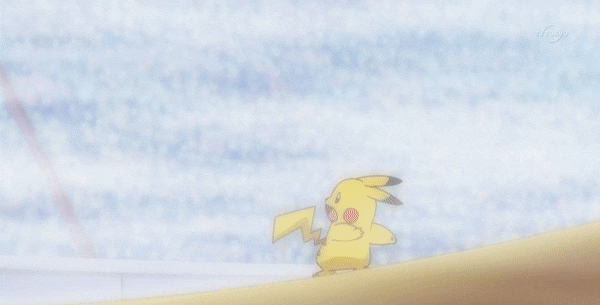
Seeeee? OK, enough background, let’s get to the movie! Film ain’t gonna watch itself, y’know. The second of four tales presented in the film Kwaidan, listed here:
The Black Hair (黒髪, Kurokami)
The Woman of the Snow (雪女, Yukionna)
Hoichi the Earless (耳無し芳一の話, Miminashi Hōichi no Hanashi)
In A Cup of Tea (茶碗の中, Chawan no Naka)
Here we go again! SPOILERS AHEAD!!!
Recap (2/4): The Woman of the Snow
We start, well...in the snow.
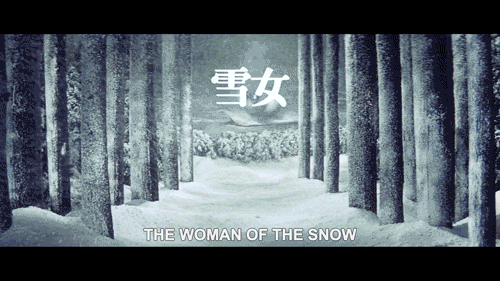
An eye glares at us through it, eerily, and we’re told of two woodcutters, Mosaku and Minokichi (Tatsuya Nakadai), an old and young man respectively. They travel from their village to the cold mountainside, and are one day beset upon by a fierce blizzard. As they trudge through it, eyes are watching them in the background. It’s extremely eerie, to be honest.

The old man is lost in the blizzard, but the young an struggles through it. As he does, he looks up and sees eyes in the sky, as if made of the moon itself. He finds himself trapped on one side of the river, and also managed to find the older man once again through it all. They make it to the hut of a boatsman, who’s already left down the river before the blizzard. But the wind is strong, and the door swings open as the wind wails, as if a voice were crying on it.
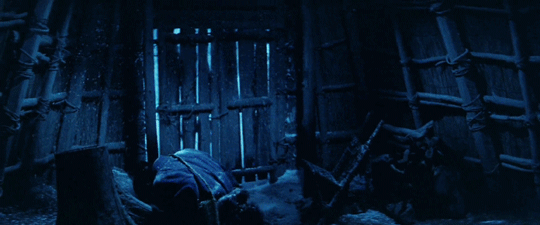
The younger woodcutter settles in for the night, and then OH NO
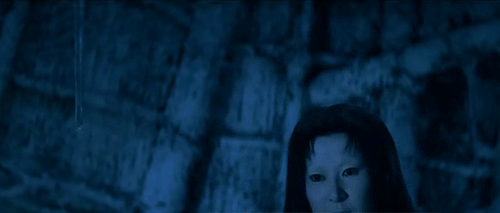
FUCK ME DUDE THAT’S GODDAMN TERRIFYING
The older woodcutter’s dead as SHIT, frozen by the breath of the Yuki-onna (Keiko Kishi). But she seems to like the younger man, smiling in a way that has scared him and me off of water for life. Like, it’s intense enough that even liquid water would remind me of this terrifying spirit. Same with the dude. But here’s the thing: I can tell you guys about this. He can’t.
See, she spares the younger woodcutter’s life on one condition: he can NEVER tell ANYONE about it. If he tells anyone, INCLUDING his mother (she specifies that), she WILL come and kill him. And odds are gonna be that that’s exactly what he’s gonna do, the great numpty.
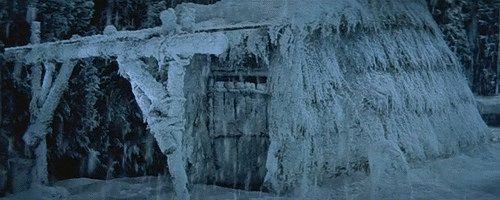
She leaves, and the blizzard eventually subsides. The man is found and nursed back to health by his mother. A year passes, and Minokichi doesn’t say SHIT about what happened. One day, he’s cutting wood in the forest, against a sunset that is definitely a set-backdrop, but still looks gorgeous. He walks past a beautiful woman, and asks what she’s doing out there. The woman is on her way to the city of Edo, and is hoping to secure a job there.
However, the two get to know each other on the walk, and start to talk. He introduces her to his mother, and we learn that her name is Yuki, and I REMEMBER THE REST OF THIS STORY NOW. It’s from Tales from the Darkside: The Movie!

YEAH. I’ve seen Tales from the Darkside: The Movie, and I haven’t seen The Godfather, I KNOW. Anyway, the film adapted this story into a short called Lover’s Vow, and replaced the yuki-onna with a...gargoyle monster, I think? Its never made completely clear. Anyway, the same thing happens, where he witnesses the creature kill somebody, and it spares his life if he doesn’t tell anyone of the encounter. He agrees, then later on meets a woman with whom he falls madly in love, and THEN...well, hold on a hot sec, here. That’ll spoil the movie.
Anyway, just like the story, this woman is the yuki-onna. I mean, c’mon, her name is Yuki, for Chrissakes. The two fall in love, and eventually have sex in a field. We had friends over, and I was gonna watch this movie at the time, and it’s a good thing I didn’t because that’d be awkward!

They marry, have three kids, and spend about ten years together. However, soon after this, Minokichi begins to realize who exactly Yuki is. The light on Yuki’s face reminds him of the night that the yuki-onna came. Without thinking about it, he tells her about that night, which he’s never told anybody about.
Here’s the thing, even during the day, we’ve seen eyes in the sky. Because she’s always watching him. and watching his actions. And as he tells the story of the yuki-onna’s visit...well...

Yeah, it’s her. After that dumbass is done with his story, she revealed herself, and spurns him for breaking his promise not to tell anyone, in exchange for his life. And he just broke that goddamn promise. And how she’s gotta kill him, and take the kids away from him as they transform into snow children, but like in Tales from the Darkside: The Movie, right?
Well...no, actually. Because, to my surprise, their kids together is what stops her. Because he broke his promise, she can no longer be a part of their lives. But she loves the children, and also loves him. She tells him that he better raise them right, and with care. If he ever mistreats then, she’ll kill him. And then...
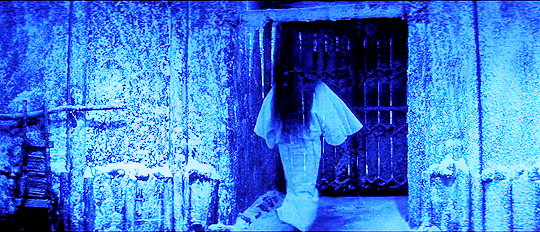
She’s gone. Minokichi leaves the sandals that he was going to give Yuki outside, heartbroken at the loss of his wife, and at his own idiocy. She accepts his gift.
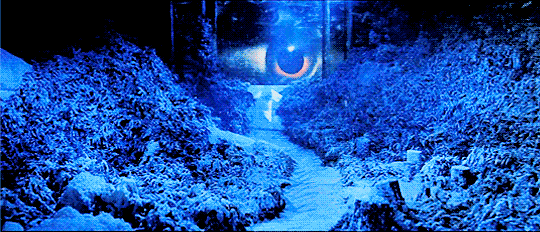
And that’s The Woman of the Snow! VERY cool. Pun...lightly intended. See you for Number 3: Hoichi the Earless! That title worries me! See you there!
#kwaidan#怪談#masaki kobayashi#the woman of the snow#yukionna#yuki-onna#Tatsuya Nakadai#Keiko Kishi#Yūko Mochizuki#usermichi#fantasy march#user365#365 movie challenge#365 movies 365 days#365 Days 365 Movies#365 movies a year
9 notes
·
View notes
Text
Nampō Roku, Book 6 (49.2): the Shin [眞] Forms of the Kō-kazari [香飾], Part 2.

49 [continued]) There is the case where a request to appreciate incense is made by the guests¹. Whereupon:
◦ the sumi-tori is carried out and placed next to the ro².
◦ From within the sumi-tori two tadon [炭團] are taken out and put into [the ro], so they will start to burn³.
◦ While adding water to the kama and so forth, the tadon will be catching fire⁴.
◦ The kōro is lowered [from the shelf], the [kō]bon is rearranged⁶, and the fukuro is removed from the kōro⁷.
◦ [Then] one tadon is put into [the kōro], to heat the ash⁸, while the other tadon is allowed to develop its hi-ai fully [in the ro]⁹.
◦ [Meanwhile, the kōro] is rested on the tray, and, once again, [the tray] is raised up onto the shelf¹⁰.
◦ Then, the kama is suspended [over the ro]¹¹.
◦ After everything else [that needs to be done in the sumi-temae] has been finished at a leisurely pace¹², because incense will follow, the ash [in the kōro] should be drawn up [into a shallow cone, to prepare it to receive the gin-yō [銀葉], and the piece of incense]¹³.
In the aforementioned instance, when the burning [charcoal] was taken [and put into the kōro], should it not have followed that [appreciating] incense would happen right away? Why, then (Rikyū asked Jōō), was [the kōro] lifted up to the shelf once again?¹⁴
[Jōō replied,] the correct condition of the heat is absolutely crucial¹⁵. If the burning [charcoal] is too hot, with heat like that the temperature will be too extreme¹⁶. [So] if you want to burn something like an old variety of meikō [名香], [this kind of heat] will be unsuitable: the condition of today’s fire is completely inappropriate¹⁷.
When a person is making preparations for [the appreciation of] things like meikō [名香], by all means, while the condition of the fire has not yet been moderated appropriately, [the host] should not be in a rush to heat [the incense in the kōro]¹⁸.
_________________________
◎ The material translated here consists of a narrative of the way that incense was appreciated during a chakai, based on the conventions established during Jōō’s middle period (Jōō’s 4.5-mat room from this period, covered with inakama-tatami, is illustrated below*).

Unfortunately, the text is abbreviated (to the point where the sequence of events is often difficult to follow), and not entirely lucid†. I have had to rely on Tanaka Senshō's commentary to clarify several especially confusing points (Shibayama Fugen, meanwhile, was unable to offer much guidance, regarding the meaning of this passage). __________ *During the shoza, the chawan and chaire were displayed on the Jōō-dana [紹鷗棚] in the tokonoma, along with the kakemono. During the naka-dachi, the scroll, chaire, and chawan were removed, and a tsuri-bune was suspended from the ten-ita of the tana.
The fukuro-dana, meanwhile, was arranged on the utensil mat, with the compartment housing the mizusashi on the left side, and the ji-fukuro on the right (towards the katte). The Jōō mizusashi-dana [紹鷗水指棚] was placed in the katte, on the opposite side of the fusuma from the host’s seat, to hold any utensils that would have to be moved from the katte to the utensil mat.
The guests entered the room from a bamboo-floored veranda, through the bank of shōji on the lower side of the room.
†These notes were written by Nambō Sōkei for his own personal reference. Nothing indicates that he ever anticipated anyone else ever perusing them. As a result, the only thing that was important, for him, was that they remind him of the critical points of the temae that is being narrated. Everything else was left out.
¹Kyaku yori kō-shomō ari [客ヨリ香所望アリ].
Kō-shomō [香所望] means to make a request to appreciate incense. This could be initiated by either the host or the guests, and, in this case, the reference is to the latter*. In this case, in the present day the request would probably be conveyed to the host from the koshi-kake machi-ai [腰掛け待合] (the covered waiting bench at the entrance to the garden), so that the host would have the opportunity to arrange the incense utensils on the shelf in the room before the guests entered for the shoza. However, apparently the request could also be made during the initial exchange of greetings†.
This is a description of the way things were done in the earliest days of Jōō's cha-kai [茶會], when many of his guests were people with whom he had become acquainted at the Shino family’s kō-kai [香會] -- that is, they were (primarily) incense devotees‡. As a result, many of these people seem to have been in the habit of bringing pieces of their prized incense** along to gatherings such as this, intent on sharing the experience with the others. It is to this practice that the present statement is referring. __________ *This is why, even today, the modern schools preserve the tradition of always keeping the kō-bon [香盆] (the tray on which the kiki-kōro [聞き香爐], filled with ash and covered, and the other incense implements are arranged) in readiness on a shelf in the mizuya. This was not a mere formality (though it usually is so today), but because, at least in the early days (the custom was revived in the Edo period), the host would have no way of knowing when one of the guests might suddenly voice a request to include the appreciation of incense. (The rules stating that host and guests must agree on what would be done days beforehand when negotiating the details of the invitation, which arose in the early 20th century, were intended to circumvent any such potentially unnerving surprises.)
†This is implied in the narrative that follows, since the action that follows the request is that the host brings the sumi-tori out from the katte and places it next to the ro (thereby beginning the sumi-temae).
‡Who were probably visiting Jōō either out of friendship, or because of an interest in purchasing some of the objects that he (as a dealer in antiques) had for sale. It seems that Jōō used his early cha-kai as a venue for displaying his wares in a setting that would provide them with context.
**Kyara incense was purchased, at auction, in the warehouses associated with the port of Sakai. These were large pieces -- often small logs, as a matter of fact. Thus the purchaser could be fairly liberal with inviting others to appreciate his incense.
This was not entirely a fraternal gesture, or an exercise in munificence, however, since it was only by gaining the incense a wide following (by exposing large numbers of the interested public to it) that there could be any hope of its acquiring the kind of wide-spread reputation that might lead to its eventually being elevated to the status of meikō [名香].
And, of course, because the original pieces of kyara were usually quite large, there was also the possibility that other devotees might approach the owner in order to purchase a smaller piece of the wood for themselves -- or trade some of it for a piece of their own special incense.
²Sunawachi sumi-tori mochi-dashi ro ni tsugi [卽炭トリ持出爐ニツギ].
Sunawachi [卽ち = 即ち], in this case, means things like “and then,” “thereupon,” “whereupon.”
Tsugi [ツギ] seems to be a miscopying*: the necessary word appears to be tsuki [付き], which means (placed) next to (the ro). __________ *Tsugi [次ぎ] generally means “next to” in the sense of sequential order or ranking; the order in which things are joined into a series. For example, the name naka-tsugi [中次] means that the lid continues from the body (that is, the side is continuous -- the lid is identical to the body).
³Sumi-tori no naka yori tadon futatsu tori-dashi kubete [炭斗ノ中ヨリタドン二ツ取出シクベテ].
Tadon futatsu tori-dashi kubete [炭團二つ取出し焼べて]: tadon [炭團] are specially made charcoal briquettes*; tori-dashi [取出し] means to fetch, draw out, unload, extract; and kuberu [焼べる] means to put something into the fire.
In other words, after bringing out the sumi-tori, the two tadon are taken out and put into the ro, so they will catch fire. __________ *They are made from powdered, high-quality charcoal, which gives off little to no smell when it burns.
The tadon are often covered with a thin leaf of silver foil, to prevent the hands from becoming soiled with charcoal dust -- since the processed charcoal cannot be washed the way ordinary wood charcoal can (If put in water, the tadon will fall apart).
⁴Kama no mizu nado tsugi-soyuru aida ni, tadon okori-shi wo [釜ノ水ナドツギソユル間ニ、タドンヲコリシヲ].
Kama no mizu nado tsugi-soeru aida ni [釜の水など次ぎ添える間に]: mizu nado tsugi-soeru [水など次ぎ添える] means adding water (to the kama)*; aida ni [間に] means while (doing something), during (the time when).
Tadon okori-shi [炭團熾りし] means the tadon begin to catch fire.
In other words, while performing the sumi-temae, the tadon will start to burn. __________ *“Adding water to the kama” requires a little explanation (since most modern schools do not do this during the sumi-temae that is performed at the beginning of the shoza).
During the ro season, the host follows a procedure known as san-tan san-ro [三炭三爐] (adding charcoal three times, for the three different conditions of the ro -- putting a new fire into the cold ro at dawn, rebuilding the fire at noon, and putting a new fire into the hot ro at dusk). While this is explained in great detail in Book Seven, briefly, the kama is put on the ro at dawn (regardless of the time when the chakai is supposed to start). Around noon, the host comes into the tearoom and adds more charcoal to the fire (while also adding some water to the kama, to replenish what has boiled away). Then, at dusk, the host empties and cleans the ro, puts in a new set of charcoal, and the places a kama of cold water over the fire. These are the usual times when the host undertakes to maintain the kama, and the guests are not usually present.
In Jōō's and Rikyū's day, the most common times to host a chakai were in the morning (the chō-kai [朝會]) and in the evening (the yo-kai [夜會]). Since the kama will have been boiling for several hours by the time the guests enter the room, it will be necessary to add some cold water to the kama during the sumi-temae performed at these times, to insure that the host will have enough water for the gathering. However, at a gathering that begins at dawn, or at dusk, no water is added because the kama will have just been filled with cold water.
Morning and evening were chosen (by Jōō) because those were the times when most people took their meals. (The practice of having a third meal around noon was a Western custom that only became common in the 20th century.)
⁵Kōro tori-oroshi [香爐トリヲロシ].
Tori-orosu [取り下ろす] means to take down, to lower.
In other words, when the host has finished adding the charcoal to the ro, and added water to the kama -- but before returning the kama to the ro -- the host turns to the shelf*, and lowers the kōbon on which the kōro (and other incense utensils) will be resting.
The reader should understand that this narration is truncated. __________ *During Jōō's middle period -- from which this narrative was derived -- the room was always a 4.5-mat room (probably with inakama mats), and the shelf was always the fukuro-dana in that setting.
⁶Bon aratame [盆アラタメ].
Aratame [改め] means to change or rearrange.
While this statement is usually interpreted to mean that the kōbon [香盆] is cleaned, it probably means that the objects on it are rearranged. For example, the koji-tate [火筋立]* is moved off of the tray (and stood on the ji-ita of the fukuro-dana, with the mizusashi). __________ *A small vase-like stand (like a miniature shaku-tate), in which the incense implements are stood.
⁷Kōro no fukuro wo nugase [香爐ノ袋ヲヌカセ].
Nugaseru [脱がせる] means to remove (someone's) clothing, to undress.
⁸Hitotsu no tadon irete hai wo atatame [一ツノタドン入テ灰ヲアタヽメ].
Hitotsu no tadon irete [一つの炭團入れて] means one of the tadon is taken out of the ro and put into the kōro.
Hai wo atatame [灰を暖め] means the ash (in the kōro) is heated.
The tadon is lowered into a hole that was made in the middle of the ash with the hibashi [火箸]* (or koji [火筋]†). However, the hole is not closed over, nor is the ash shaped. Warming the ash helps to remove any moisture that may be present (since burying a tadon in damp ash will cause it to go out).
This tadon will be removed and discarded before the kōro is prepared for the incense. __________ *Hibashi [火箸] refers to the hibashi that are part of the sumi-dōgu, the utensils carried in the sumi-tori.
†Koji [火筋] are miniature hibashi, usually made of silver or bronze, that are stood in the koji-tate.
Usually the host of a chakai simply uses the hibashi to perform these tasks (opening a hole in the middle of the ash, and lifting the tadon out of the ro), but in the early days he may have preferred to use the proper incense utensils.
⁹Ima-hitotsu no tadon wo tokuto hi-ai shite [今一ツノタドンヲトクト火相シテ].
Tokuto [篤と] thoroughly, fully, carefully.
Hi-ai suru [火相する]: hi-ai [火相] means the condition (or strength) of the fire; hi-ai suru [火相する] means to develop the hi-ai.
In other words, the second tadon is allowed to remain in the ro, so that it will catch fire fully.
¹⁰Bon ni nose, mata tana ni age [盆ニノセ、又棚ニアゲ].
Bon ni nose [盆に載せ] means (the kōro) is loaded onto the tray. Mata tana ni age [又棚に上げ]: mata [又], once again; tana ni age [棚に上げ] means (the kōro) is lifted up to the shelf.
The kōro is placed on the tray and the tray is then lifted up onto the shelf (of the fukuro-dana) principally to get these things out of the way* while the host finishes the necessary work of the sumi-temae. __________ *Though the kama was usually lifted up onto the mat near the mizusashi (and remained there throughout an ordinary sumi-temae), in this case, since the host needs that area to prepare the kōro, the kama was moved to the far side of the mat. The only way it can be returned to the side next to the ro is if the kōbon has been moved out of the way first.
Unfortunately the extremely abbreviated nature of this narrative creates these unnecessary ambiguities for the modern-day reader. Such criticisms are irrelevant, however, because we must remember that these notes were written by Nambō Sōkei for his own reference.
¹¹Sate kama wo kake [サテ釜ヲカケ].
Sate [扨] means next.
Kama wo kake [釜を懸け] literally means that the kama is hung up or suspended.
In other words, the kama is returned to the ro.
Kakeru [懸け]* means to hang or suspend something. When Jōō first began to use the ro, the kama was suspended from the ceiling on a chain. The creation of the gotoku [火卓 = 五德] came later†. __________ *The verb used with respect to the furo is the homophonous kakeru [掛ける], which means to rest upon or lean against. This is because the original furo was the kimen-buro [鬼面風爐], on the rim of which the kiri-kake gama [切り掛け釜] rests.
Subsequently, the two kanji have come to be used interchangeably, in chanoyu.
†The idea was inspired by the futaoki known as the kakure-ka [隠れ家], which was originally a trivet on which the saucer of oil rested inside a nightlight. This object was increased in size, with wide, flat feet (usually notched with parallel lines, to prevent the gotoku from slipping in the earliest versions -- technically they are called tsume [爪] or “claws,” rather than feet) added to the ends of the legs; it was oriented, in the ro or furo, in the same way as the trivet was in a nightlight, with the ring uppermost.
Until 1582, the gotoku was always used with the ring above, and the feet resting on the surface of the ash. Only after Rikyū created the small unryū-gama for use in the large iron kimmen-buro (that had belonged to Yoshimasa; and later Nobunaga) was the gotoku turned over so that the ring is buried in the ash, and the erstwhile feet are pointed upward, with the kama resting on top of them.
This was done in response to the specific conditions that Rikyū encountered with the large kimen-buro. If oriented with the ring uppermost, the gotoku restricted the airflow through the furo, resulting in a weak fire (that could easily go out). Turning the gotoku over allowed the air to flow upward freely between the rim and the side of the kama. Following this precedent, Rikyū‘s contemporaries quickly adopted the practice, so that now the fact that the gotoku was originally used with the ring uppermost has been forgotten.
Gotoku was originally written ko-taku [火卓] (dialectically modified to sounds approaching ko-toku], which is the actual name of this kind of trivet. Gotoku [五德] is a kind of word-play that arose when Dōan (Rikyū’s only biological son) created the Dōan-buro by cutting away the upper edge of the hi-mado [火窓] (the air hole in the front of a furo) of an old ceramic mayu-buro [眉風爐]. Since the gotoku was still used with the ring uppermost (Dōan is said to have still been a teenager at that time), removing the mayu [眉] (which means eyebrow) meant that the ring would be crossing the opening, which looked bad. So, Dōan cut off the front third of the ring as well, making the “furo-yō no gotoku” [風爐用の五德] that we know today.
Jittoku [十德] (a contraction of jū-toku [十德], meaning “ten virtues”) is the name of a monk’s outer robe -- which was also worn by chajin when officiating at a gathering as the host (regardless of the kind of garments that they wore underneath). “Go-toku” [五德] (“five virtues”) alludes to this garment, albeit one that has been torn in half or partially dismembered.
¹²Sōji yuru-yuru shimatte... [サテ釜ヲカケ、諸事ユル〰仕���テ...].
Sōji [諸事] means everything, the rest of the tasks (that have to be done in the sumi-temae).
Yuru-yuru [ゆるゆる] means comfortably, slowly, easily.
In other words, the host should finish the sumi-temae in a leisurely manner. In particular, he must be careful to avoid giving the impression that he is hurrying things along -- because he is worried that the second tadon (which is kindling in the ro) might go out).
¹³...Ato, kō wo tsugite desaru, hai ha kaki-age nari [...後、香ヲツギテ出サル、灰ハカキアゲ也].
Ato [後], meaning “after,” refers to the completion of the previous phrase -- that is, after the host has finished the sumi-temae.
Kō wo tsugite desaru [香を次ぎて出さる] means “(the appreciation of) incense will come next.”
Hai ha kaki-age nari [灰は掻き上げなり]: kaki-age [掻き上げ] means to rake or scrape something upwards. This refers to the shaping of the ash in the kōro into a shallow cone (using the hai-oshi [灰押し]*, which is shown below -- this is one of the things that are stood in the koji-tate).

Once again, Nambō Sōkei has abbreviated the narrative to the point where it cannot be understood without interpolating several explanatory remarks.
After the kama has been returned to the ro and the sumi-temae has been concluded†, the kō-bon is once again lowered to the mat. The piece of charcoal that has been warming the kōro is discarded‡, and the second piece, which has been kindling in the ro, is removed** and inserted into the ash in the kōro. Then the ash is shaped into a shallow cone with the hai-oshi. The censer is now ready to receive a gin-yō [銀葉] (mica square), on which the piece of kyara will be heated. __________ *In actual fact, rather than “raking” the ash upward, it would be more correct to say that after drawing it upward into a roughly cone-like shape, the ash is very gently pressed into its finished shape with the hai-oshi (which is literally what the name means).
†In other words, after the ro-buchi [爐縁] and ro-dan [爐壇] have been cleaned with the habōki, and the charcoal utensils have been returned to the sumi-tori.
Because incense will be appreciated afterward, the host does not add any sort of incense to the ro.
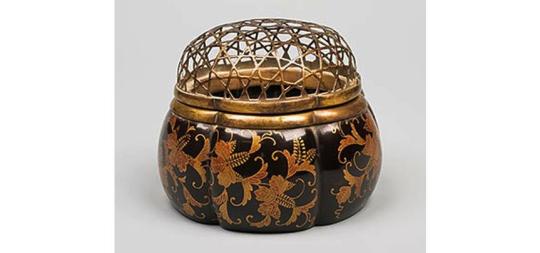
‡Usually into a fairly large vessel called an akoda-kōro [アコダ香爐], shown above; but some people put it into the hai-ki, or even the ro.
**When incense will be appreciated, if the kama is resting on a gotoku, the orientation of the kama has to be adjusted before the sumi-temae is performed:
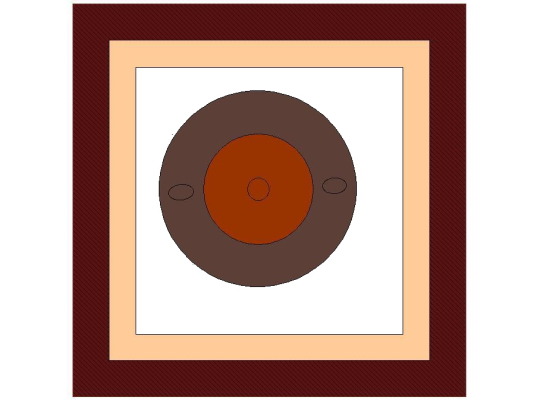
the gotoku is pushed diagonally toward the left rear corner of the ro, as shown aboveᵃ. This allows the host to reach into the ro (with the hibashi) after the kama has already been returned to its place, so he can extract the second tadon without disturbing the kamaᵇ. (The smaller kama that is suspended on a chain, however, will not get in the host's way, so nothing special needs to be done in that case.)

Ha-gama [羽釜] that rest on suki-gi [透き木] -- that is, a kama with a projecting flange, which allows it to rest on the top of the ro-dan (on top of a pair of small wooden blocks, called suki-gi) -- were one of the early types of kama that were used with the ro. Kama of this sort that date from Jōō’s middle period (a representative example being Jōō’s hira-gumo gama [平蜘蛛釜], shown above) always have the flange broken away on the side that faces the right-front corner of the ro, for the purpose of allowing the host to reach into the ro without disturbing the kama. (Ha-gama that were cast later often do not preserve this feature.)
This is also why the gotoku is always rotated slightly, rather than being arranged so that two legs are in the front and one in the middle of the back. ___________ ᵃBecause of the necessity of reorienting the gotoku and kama, for the guests to wait to ask for the appreciation of incense to be included during the shoza until the initial exchange of greetings would be extremely rude. Thus, if not earlier, a message would usually be sent in to the host after the guests arrive at the koshi-kake.
Unfortunately, this entry is not well organized, and, to make matters worse, its contents may have been fiddled with in the Edo period.
ᵇIf the host had to lift the kama out of the ro once again in order to access the second tadon, this would interfere with its coming to a boil. That, in turn, would throw off the host’s timing -- not only of the shoza, but also of the goza (since, in the early days, the sumi-temae was usually performed only once, at the beginning of the gathering, with the fire expected to last until the host was finishing the service of usucha).
¹⁴Migi hi wo tori-taru toki, kō wo tsugu-beki-koto naru ni, nani to te mata tana ni agerare-taru zo to Ō [h]e Kyū tazunerare-shi ni [右火ヲ取タルトキ、香ヲツグベキコトナルニ、何トテ又棚ニ上ラレタルゾト鷗ヘ休尋ラレシニ].
Migi [右] refers to the just-narrated sequence where, after putting the first tadon into the kōro, the censer is placed on the kōbon, and the kōbon is lifted up onto the shelf once again.
Hi wo tori-taru toki [火を取りたる時] means “when the fire is taken (out of the ro and put into the kōro).”
Kō wo tsugu-beki-koto naru ni [香を次ぐべきこと成るに]: tsugu-beki-koto [香を次ぐべきこと] means the case (koto [こと]) where (incense) should [-beki [べき]) follow (tsugu [次ぐ]); naru ni [成るに] means be done, be attempted.
In other words, once the burning tadon has been taken (out of the ro and put into the kōro), the (appreciation of) incense should follow forthwith.
Nani to te mata tana ni agerare-taru zo [何とて又棚に上げられたるぞ]: nani to te [何とて] means why is it?, why is that?; mata tana ni agerare-taru [又棚に上げられたるぞ] means once again (mata [又]) to the shelf (tana ni [棚に] will it be raised (agerare-taru [上げられたる]); zo [ぞ] makes Rikyū's query emphatic or more forceful*.
Ō [h]e Kyū tazurare-shi ni [鷗へ休尋られしに] means [Ri]kyū asked (this question) of [Jō]ō.
If this entry actually documents a historical incident†, this exchange probably took place before Rikyū undertook his journey to Korea, and so when he was 19 or 20 years of age. While Rikyū had studied the tea of the daisu with Kitamuki Dōchin, he appears to have been unfamiliar with the appreciation of incense prior to his contact with Jōō‡. __________ *Zo [ぞ] indicates, in this case, that he is really perplexed about this matter.
†Nambō Sōkei was at least several years older than Rikyū (and perhaps as much as a decade older), and was one of Jōō's principal disciples. Consequently, it is very likely that Sōkei had heard all about Rikyū (from Jōō) from the time that Rikyū was first introduced to Jōō by Kitamuki Dōchin. Sōkei, then, may have remembered this story years later, when he was writing about the way that incense was appreciated at a tea gathering during the early days.
‡His connection with the Shino family seems to have begun after he returned from the continent.
He may have been introduced to Shino Shōpa [志野省巴; 1502 ~ 1571] -- the last generation of the original (Korean immigrant) branch of the Shino family -- by Jōō (since Jōō and Shōha were of the same generation). But, in any case, Shōpa is mentioned as having been one of Rikyū's closer friends in the years following Jōō's death (up until his own death, in 1571).
Rikyū is listed among Shopa's major disciples.
¹⁵Kō ha hi-ai kan-yō nari [香ハ火相干要也].
Hi-ai kan-yō nari [火相肝要なり] means that the correct condition of the fire (hi-ai [火相]) is crucial (in order to properly appreciate incense).
About this matter, Tanaka Senshō wrote: “[when appreciating incense] the salient point is that the intensity of the heat source must be controlled very carefully. This is a difficult matter. A beginner feels that having a strong heat is better; but when it comes to [the appreciation of] famous incense, especially, the heat should, in fact, be very gentle.
“It is said that you can appreciate a piece of incense nine times if it is heated over a gentle heat-source: for example, [something like] ‘Ranjatai’ [蘭奢待] should be passed around [the room] nine times. But if the heat is too strong, [the piece of kyara] will be burnt up at once and become a cinder.*”
The heat from the tadon that is put into the kōro for the appreciation of incense should actually be declining. This will protect the incense, so it can be appreciated more thoroughly and deeply†. __________ *For those who wish to read the entirety of Tanaka’s comments (which begin with his cataloging his experience with the Shino school of kōdō, followed by the claim that, while it is all easy for him to understand, it is not necessary to go into the details when explaining all of this to people with no training in incense -- a rather condescending speech that does nothing to further our understanding), I have transcribed them for your reference: 本条を香道の作法に基きて構義すると、少しく香の専門に渉り過ぎるから略する。予は近年志野流の香を研究して居る故、這般の消息は能く読めるが、普通の素人に説明しても解し兼ると思ふから略するが、要は、香の火加減の六つかしい事である。初心の間は、火加減は強いのを好むものであるが、名香抔になると頗る弱い火相を賞翫する。蘭奢待九遍返しの法抔云ふて、一炷の香片を、弱い火相で九度も聞く故事抔あるが、火相が強ければ一度で焼け切りて、炭化して仕舞ふものである。
In my translation, I have limited myself to that portion of his remarks that has a direct bearing on the condition of the tadon.
†In other words, the longer the incense has been smoldering, the weaker the heat becomes.
The fragrance given off by a smoldering piece of kyara changes over time. Afficionados argue that it is the fragrance of the latter stages of burning that is most exquisite, so the incense should be no hotter than necessary to cause the volatile elements to evaporate in order -- otherwise the substances that produce the latter aroma will be lost together with the more easily released chemicals in a noxious puff of smoke, ruining the kyara entirely.
¹⁶Okori-tate-taru hi, sono-mama ni takite ha hi-ai suru do ni shite [ヲコリ立タル火、ソノマヽニタキテハ火相スルドニシテ].
Okori-tate-taru hi [熾り立てたる火] means (a piece of charcoal) that is burning (too) strongly; a blazing fire.
Sono-mama ni takite ha [そのままに炷きては] means if you heat (the incense) on (a fire) like that....
Hi-ai suru do ni shite [火相する度にして] means the temperature of the hi-ai is (too extreme).
¹⁷Koboku no meikō nado sōō-sezu, kyō no hi-ai mo jū-bun ni ha naki nari [古木ノ名香ナド相應セズ、今日ノ火相モ十分ニハナキ也].
Koboku no meikō nado [古木の名香など] koboku [古木] means old wood (which will be extremely dry); meikō [名香] means a famous variety of incense; nado [など] means and things of that sort.
Sōō-sezu [相應せず]: sōō [相應] means to be suitable, to be suited for; -sezu [-せず]* means without, not.
In other words, a very hot heat-source is not suitable for the appreciation of old, dry, kyara -- especially if it is of a famous variety of incense. __________ *Sezu [爲ず] is the negative form of suru [爲る].
¹⁸Meikō nado dasan to shitakushitaru hito ha, ze-bi tomo hi-ai totonowanu uchi ni, kokoro-sekite taku bekarazu to iu-iu [名香ナド出サント支度シタル人ハ、是非トモ火相トヽノハヌ内ニ、心セキテタクベカラズト云〻].
Meikō nado dasan to shitakushitaru hito ha [名香など出さんと支度したる人は] meikō nado [名香など] means famous incense, and things of that sort; dasan to shitakushitaru hito ha [出さんと支度したる人は] means the person (hito [人]) who is probably (dasan to [出さんと]) going to be making preparations (shitakushitaru [支度したる]).
In other words, Jōō is speaking about someone who is probably going to be making preparations for appreciating a famous variety of incense*. The indirection of his speech† is typical of a classically trained poet of the era.
Ze-bi tomo hi-ai totonowanu uchi ni [是非とも火相調わぬ内に]: ze-bi tomo [是非とも] means by all means, absolutely; totonowanu-uchi ni [調わぬ内に] means during the time before (the condition of the fire) is properly moderated.
Kokoro-sekite taku bekarazu [心せきて炷くべからず] means don’t be in a hurry to burn it‡; to be impatient to burn it. __________ *This was no casual matter. Meikō was extremely costly. But more, it was extremely hard to come by, even if one had the money.

For example, from the time it was presented to the Emperor Shōmu [聖武天皇; 701 ~ 756] in the eighth century, pieces were taken from the famous Ranjatai [蘭奢待] incense only four times: in 1465, as a gift from the Emperor Go-tsuchimikado [後土御門天皇; 1442 ~ 1500] to Ashikaga Yoshimasa [足利義政; 1436 ~ 1490]; in 1574, as a gift from Emperor Ōgimachi [正親町天皇; 1517 ~ 1593] to Oda Nobunaga [織田信長; 1534 ~ 1582] (from whom Rikyū was granted a small piece); in 1502, when Tokugawa Ieyasu [徳川家康; 1543 ~ 1616] requested a piece; and finally, in 1877, when the Emperor Meiji [明治天皇; 1852 ~ 1912] took a piece for himself. (The places where these pieces were cut are marked by paper tapes in the above photograph, where the details were noted accordingly.)
†The use of dasan to shitakushitaru [出さんと支度したる ] “probably going to make preparations” rather than simply stating someone who is going to prepare is an example of this kind of indirect speech.
‡Taku [炷く] means to burn incense -- in the sense of heating the incense so that it gives off its fragrance (not destroying it, or ruining it, by fire).
1 note
·
View note
Text
Nampō Roku, Book 6 (33.3): the Kaki-ire [書入], Part 2: Tsuda Sōkyū’s Disciples Ask to Inspect the Tearoom After Rikyū’s Temae with the Naga-ita [長板] had Already Begun.

33.3) Kaki-ire [書入] (continued):
On one occasion when Rikyū was [practicing with] the naka-ita, [he] had already begun the temae¹: he carried out the mizusashi; and [then] the chaire and chawan were brought out, and placed in front of the mizusashi, [after which] he [proceeded] to dust [the mat] in front of the board with the habōki².
Before he had finished, a group of guests [arrived and] asked if it would be alright for them to have a look at [the room].
[Ri]kyū said: there is no case where the early [stages of the] display may be viewed while the board is being arranged. If [you] insist on being allowed to look at it, [Ri]kyū will be very displeased.
Even though they should have known better -- considering they were the disciples of Sōkyū -- they [apparently] did not remember this [rule].
Because [Rikyū] had been in the middle of carrying things out for the temae, there was nothing worth seeing -- since, in the case of the naka-ita, [for the host] to say that he has [also] intentionally placed [some of the utensils] on the tatami is a mistake. And having made this reply, the guests were convinced [to withdraw their request].
Though [guilty of] having made a thoughtless request, instead [they] were rewarded by this [gift of] excellent guidance.
_________________________
◎ Once again, the contents of this kaki-ire [書入] are somewhat confused. While the first part of the kaki-ire (see the previous post) concluded with the admonition that “if it is a treasured piece, it is all the more appropriate to carry the mizusashi out [at the beginning of the temae],” it is actually unclear from the context whether Rikyū has brought the mizusashi out* before, or after, the guests were supposed to have entered the room and taken their seats†.
The point of this section is to establish the rule that, when using the naga-ita [長板], it is wrong to also display some of the utensils on the mat in front of the board‡.
And again, the language used is completely atypical for Rikyū (or for Nambō Sōkei), indicating that this narration was added to Book Six years later. So while the idea expressed in this second part of the kaki-ire is acceptable -- and correct, in so far as Rikyū’s teachings go -- the language indicates that the information was added many years later, during the Edo period. As does the “morality tale” form of the essay. __________ *Rikyū was rehearsing a temae, thus no guests were ever supposed to be present.
†Because he is practicing, there were no other people in the room in any case. The group of guests who arrive during his temae have nothing to do with any of this, and appear to have decided to call on Rikyū spontaneously, and uninvited.
‡Anything that will not fit on the board is supposed to be carried out at the beginning of the temae, at least according to this entry.
The modern schools, however, do not observe this teaching.
The justification for the second part of this kaki-ire seems to have been because, even at the beginning of the Edo period, people were already in the habit of arranging the chaire, or the chaire and chawan, on the mat in front of the naga-ita during the naka-dachi, so that these things would already be in situ when the guests entered the room for the goza.
By the way, the same rule also applies to the daisu. Displaying the chaire, or a chawan, on the mat in front of the daisu is wrong.
¹Aru-toki Kyū ni te naka-ita no toki, temae ni kakarite [アル時休ニテ中板ノ時、手前ニカヽリテ].
Kyū [休] is the usual abbreviation of Rikyū's name.
Temae ni kakarite [手前に掛かりて]: kakarite [掛かりて] means to have started, to have commenced.
In other words, during this episode Rikyū was practicing to use the naga-ita (probably in anticipation of using it at an upcoming gathering), and the narrative begins at the point where Rikyū has just brought the chaire and chawan out from the katte (as the first step in the koicha-temae).
The critical thing is that the point at which he was interrupted has the utensils distributed on the utensil mat in a way that should never be seen apart from the temae. Having stopped at that point to go out and receive this group of guests, it would give them a very wrong impression were he to then allow them to enter the room and inspect the arrangement on the utensil mat (since the logical conclusion that they would make would be that the chaire and chawan may be displayed on the utensil mat in front of the naga-ita at the beginning of the goza).
²Mizusashi wo hakobi, chaire・chawan mochi-dashi, mizusashi no mae ni oki, habōki ni te ita-mae wo hahaki [水サシヲ運ビ、茶入・茶盌持出、水サシノ前ニ置、羽帚ニテ板前ヲハヽキ].
Mizusashi wo hakobi [水指を運び]: the mizusashi was brought out -- and probably lifted onto the naka-ita*.
Mizusashi no mae ni oki [水指の前に置き]: the chaire and chawan, having been brought out from the katte, were arranged on the mat in front of the mizusashi.
Habōki ni te ita-mae wo hahaki [羽箒にて板前を掃き]: hahaku [掃く] is an archaic pronunciation†.
The meaning is that, after bringing out the mizusashi, and then the chaire and chawan (and placing them in front of the mizusashi), Rikyū had then begun to sweep the mat in front of the naka-ita with a habōki‡. __________ *After which the host would bring out a mizu-tsugi and filled the mizusashi to 90% of its capacity.
†The verb is usually pronounced haku [掃く] today (there is no difference in the written form). The pronunciation hahaku [掃く] seems to have been used most frequently in poetry -- probably when an extra syllable was needed.
‡The traditional way the mizusashi is carried out and arranged on the naga-ita is:
◦ the mizusashi is brought out from the katte and temporarily rested on the mat in front of the naga-ita;
◦ then the host takes a towel from the futokoro of his kimono, and cleans the naga-ita;
◦ then the mizusashi is lifted up onto the naga-ita;
◦ the host then goes back to the katte and returns with a mizu-tsugi (on top of which is resting a chakin), and adds water to the mizusashi (filling it to approximately 90% of its capacity so there will be sufficient water for the service of both koicha and usucha);
◦ after wiping the mouth of the mizusashi with the chakin the host picks up its lid, cleans that with the chakin (if it is a tomo-buta [共蓋], a lid made of the same material as the mizusashi itself), and closes the lid;
◦ taking out the towel again, the host wipes the naga-ita, to blot up any splashed water, after which he returns the kata-kuchi to the katte;
◦ returning to the temae-za, the host dusts the utensil mat with the habōki.
This should be done whether or not the guests are present in the room (in other words, whether the mizusashi is brought out during the naka-dachi, or whether it is brought out at the beginning of the koicha-temae).
After the mat has been swept:
◦ the host carries the chaire and chawan out from the katte, and places them on the mat in front of the mizusashi;
◦ after bringing the koboshi to the utensil mat, the host rests the hishaku on the futaoki, and all bow for the sōrei.
Again, this is the same regardless of when the guests enter the room. (In other words, the guests could enter the room after the mizusashi has been carried out and the mat swept with the habōki, or before; but in either case, the host's actions are supposed to remain the same.)
That said, there are only two possibilities, with respect to the order of the narration as quoted in the kaki-ire:
- the case for dusting the utensil mat with the habōki after the chaire and chawan have been brought out would only be possible if the chaire and chawan were placed on the naga-ita (though there is no known furo naga-ita temae that includes this practice -- and certainly none that were sanctioned by Rikyū -- which is why Tanaka Senshō argued that this was a misrepresentation of a daisu temae, where the chaire and chawan would have been lifted onto the ten-ita);

- however, the simplest (and probably correct) explanation is that the narrator made a mistake when copying the text onto the page (on which Sōkei’s entry had already been written), and that the cleaning of the utensil mat with the habōki took place before the chaire and chawan were brought out (weight is given to this interpretation later in the narrative, because the point of the episode appears to be to establish the rule that, when using the naga-ita, nothing should be resting on the mat in front of the ita when the guests enter the room for the goza).

At the point where the host began to dust the tatami with the habōki, the arrangement of the utensil mat would have looked like that shown above. Consequently, for the chaire and chawan to be present on the mat in front of the naga-ita when the guests enter the room (as shown below) indicates that something is definitely wrong -- that the temae has already progressed beyond the point where it is acceptable for them to do so.

It is important to point out that many modern schools ignore this rule (or, more probably, were never aware that such a rule existed), and traditionally display the chaire, or the chaire and chawan, on the mat in front of the naga-ita before the guests enter the room. (Some schools even do things like this when serving tea with the daisu -- which is equally wrong.)
³Temae tori-tsukan to serareshi toki, kyaku-shū o-kazari ichiran mōshitaki yoshi-mōsare [手前取ツカントセラレシ時、客衆御カザリ一覧申タキ由被申].
Tori-tsukan to serareshi toki [手前取つかんと為られし時]: tori-tsukan [取つかん] is a negative form*, meaning to have not begun, or to have not (yet) completed an action; the auxiliary verb serareru [為られる] indicates the causative (the potential to do something).
In other words, at this point Rikyū was at an intermediate step in his temae: the utensils were not arranged in a manner acceptable for inspection by guests.
Kyaku-shū [客衆] means a group of guests. Since they apparently surprised and interrupted Rikyū with their arrival, it might be safe to assume that they had not been invited, but came to visit him spontaneously, of their own volition†.
This kaki-ire was written in the Edo period, and so we have to understand that it is describing a kind of situation that existed in the popular imagination of that time (it seems unlikely that a group of people would just burst in on a host in this way -- especially an important government official‡ -- demanding entertainment).
Ichi-ran [一覧] means to take a look at (something).
Mōshitaki yoshi-mōsare [申したきよし申され]: [申したき] moshitaki means to declare, to state; yoshi-mōsare [よし申され] means to say something is alright, to receive permission to do something.
In other words, Rikyū was interrupted after bringing the chaire and chawan out (which is the first step in the koicha-temae). When the guests were announced, he was told that they wanted to look at the room (since they had apparently been informed that Rikyū was rehersing a temae). __________ *Negative verb forms ending in -n [ん] have a rather coarse sound, and so were used exclusively by men.
†Edo period anecdotes featuring the sudden, unexpected arrival of guests probably make this practice seem more common than it actually was -- especially in the case of Rikyū who, as a high government official, would have been sequestered behind multiple layers of checkpoints.
‡Book Six generally seems to contain essays that date from the years when Rikyū was a member of Hideyoshi's household. It appears that Nambō Sōkei acted as a sort of unofficial steward for Rikyū's household in Sakai during this period (because Rikyū's first wife, who would have normally been charged with this kind of responsibility, was dead), and he may have passed the time by authoring this collection of essays. Even though the kaki-ire was added later, the author has contrived his comments to give the impression that they were contemporaneous with that period.
⁴Kyū no iwaku, saizen kazari ha goran naku sōrō ya to arishi ni, ita no kazari ha ichiran tsukamatsuri-sōrō, o-chagu no kazari mi-mōshikere ba, Kyū fukigen ni te [休ノ云、最前カザリハ御覧ナク候ヤトアリシニ、板ノカザリハ一覧仕候、御茶具ノカザリ見申ケレバ、休不機嫌ニテ].
Saizen kazari [最前飾] means the arrangement at the very beginning of the process of preparing the room for the goza. This was never supposed to be seen by the guests.
Fukigen [不機嫌] means things like glumly, sullenly, dourly, in a bad mood, displeased, and so forth.
Rikyū was extremely annoyed at their request.
There is a sort of discrepancy here: in fact, Rikyū seems to have already finished creating the initial arrangement, and was now beginning the temae itself, so the mention of saizen-kazari would appear to be irrelevant.
⁵Sasuga no Sōkyū no deshi-shū to mo oboenu-koto tamau, kaku-no-gotoki hakobu-toki ha, haya temae no uchi ni te sōrō [サスガノ宗及ノ弟子衆トモヲボヘヌコトノ玉フ、如此運ブトキハ、ハヤ手前ノ内ニテ候].
This statement is saying that, since these people were the disciples of Tennoji-ya Sōkyū, they should have known better than to burst into someone's house, and insist upon inspecting rooms that the host indicated he did not want them to see.
⁶Temae ni narate kazari no mi-mono ha naki-koto ni sōrō [手前ニ成テカザリノ見物ハナキコトニ候].
Temae ni narate [手前に成て] means that (Rikyū) had been in the process of performing the temae.
Kazari no mi-mono ha naki-koto [飾の見物はなきこと]: mi-mono [見物]* means something to be seen, something that is worth seeing; naki-koto [なきこと] means "does not exist." __________ *Today, this compound is usually pronounced ken-butsu [見物].
However, the nuance associated with ken-butsu inclines toward things like sightseeing, describing something as “an attraction.” Here, the compound is used much more literally, to mean something that someone wishes to look at.
⁷Koto-sara naka-ita ni tatami no ue no oki-awase to mōsu-goto ha naki-koto ni sōrō to mōsare-kereba, kyaku-shū sate ha to kanpuku-shi [コト更中板ニタヽミノ上ノ置合ト申事ハナキコトニ候ト被申ケレバ、客衆サテハト感伏シ].
Koto-sara [こと更] is koto-sara [殊更], which means deliberately, by design, intentionally.
In other words, Rikyū is saying that, in the case of the naga-ita, to say that the host has also intentionally arranged some of the utensils on the mat is wrong -- though this idea could be assumed were Rikyū to allow these guests to look at the room.
Kanpuku-shi [感伏し] is a variant written form of kanpuku-suru [感服する], meaning “to be impressed (by something).” It can also indicate conviction, or to be convinced (by an argument).
In other words, Rikyū's explanation convinced them of the inappropriate nature of their request.
⁸Sotsuji wo mōshiidetare-domo, kaette yoki go-shinan wo e-sōrō to yorokobareshi nari [卒爾ヲ申出シタレドモ、却テヨキ御指南ヲ得候トヨロコバレシ也].
Sotsuji wo moshiidetare-domo [卒爾を申し出たれども]: sotsuji [卒爾] means things like abrupt, sudden, careless, thoughtless; mōshiide [申し出] means to propose, to ask, to voice a request.
Kaette [却って] means rather, instead of, on the contrary.
In other words, rather than being scolded or simply refused outright, Rikyū turned this into a teaching moment.
Yoki go-shinan [良き御指南]: yoki [良き] means goodness, good; shinan [指南]* means teach, instruct, give a lesson (in).
E-sōrō [得候う] means to gain, to be benefited by (something).
Yorokobareshi [喜ばれし] means to be delighted, to be gladdened, to be pleased.
In other words, the group of guests were pleased to received some excellent instruction from Rikyū, in return for their thoughtless request. __________ *Go-shinan [御指南] is the honorific form.
2 notes
·
View notes
Text
March 13, 2021: Kwaidan (Review)
How do you review an anthology?

Either I go section by section, or I review it all in one shot. Since it’s all one director and writer, the latter seems appealing, so I probably will go with that...but maybe not for all five sections. Hmm...an idea occurs. I think I’ve got it. But, before I go into that, what did I think of Kwaidan on first recall?
Also, real talk, the above GIF is now one of my favorites, and I WILL be using it in the future.

Kwaidan is an understates masterpiece, and one of the many reasons I’m glad I’m doing this misguided film project of mine. It’s genuinely great, and also a wonderful ghost story in its own right. I don’t get scared easily, and I can’t say that this film particularly frightened me, but I can say that it was an unnerving movie in many instances. As for which segment was my favorite...oof, genuinely a tough question to answer. I love how In A Cup of Tea ends, and The Woman of the Snow is a gorgeous fever dream of a sequence. The Black Hair is EASILY my least favorite, but it’s still a good starting point.
But as for my favorite...
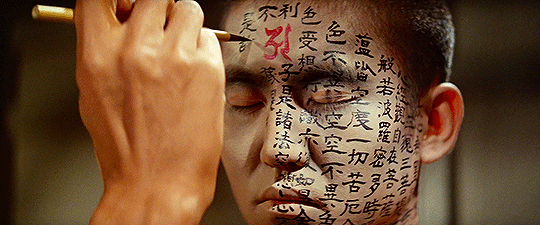
And in truth, I’m not completely sure I can articulate why. It’s close between this and The Woman of the Snow. Tea was a little too short for my tastes (even though I think it had the best ending), and Hair was...well, just fine, like I intonated above. Snow has some amazing visuals, and a great story, which may have been ruined for my by Tales from the Darkside: The Movie, but still was wonderful. But Hoichi...Hoichi was magnificent.
I love Hoichi himself, the opening kabuki theater is amazing in sound and appearance, and the reappearances of the visuals is stunning throughout. All I gotta say is, I loved every single part of this one. And yeah, it’s arguably the only one with a mostly happy ending, all things considered. But I may get more into that in the Review.

Yeah, speaking of that, how are we doing this? Well, some segments will be broken up by...segment, while others won’t be. Depends, you’ll see. So, let’s get to it! Below are listed the four segments, and their recaps. Click on them to read them in full!
The Black Hair (黒髪, Kurokami)
The Woman of the Snow (雪女, Yukionna)
Hoichi the Earless (耳無し芳一の話, Miminashi Hōichi no Hanashi)
In A Cup of Tea (茶碗の中, Chawan no Naka)
Without further ado, then...
Review
youtube
Cast and Acting: 9/10
Breaking this one up! Not a single shared cast member amongst any of the shorts, so this one is broken up by necessity.
Hair (8/10): Sorry to say, but this is arguably the weakest cast in the group. Granted, it’s not that many people, but it’s still not the strongest of these stories. The lead here is Rentarō Mikuni, and he’s fine. My only problem is that it feels like he’s acting. Which, to be fair, is very kabuki theatre. You know, over-exaggerated movements and emotions, all that jazz. But, without the physical trappings of kabuki, it just feels like, well...overacting. Again, not the worst, but not the best. Michiyo Aratama and Misako Watanabe are good as well, but they’re parts aren’t hefty enough for me to properly judge. Well, actually, Aratama is quite good, real talk.
Snow (10/10): Amazing. Keiko Kishi is absolutely enrapturing as the Yuki-onna, and Tatsuya Nakadai ain’t bad as Minokichi either, lemme say. Again, limited cast for this one, but they definitely manage to excel. Seriously, they’re great.
Hoichi (10/10): This one has some of the best, though, both in terms of the kabuki scene, and in the regular scenes. The range of performances here is interesting, considering that you have the overdramatic stylings of kabuki on when end, the gentle nature of Katsuo Nakamura’s Hoichi on the other end, and the actually entertaining comedy relief monks in the middle. Yeah, I never mentioned it, but there are comedy relief monks in this segment, and they’re funny! This one is, all-around, a really strong cast, and the best in the film for sure.
Tea (8/10): This one is strong too, don’t get me wrong. Nakamura Kan'emon is a strong lead, but he’s not...perfect. Nor is Nokobu Nakaya as the ghost of Shibuku Heinai. Even the three samurai are a bit stiff. But in truth, it doesn’t interfere with the short, even a little bit. The 8 out of 10 is how I feel about it, but I genuinely don’t have a problem with it.
Average score’s a 9/10, which feels totally accurate to me. Moving on!

Plot and Writing: 10/10
I was going to break this one up, since they all have different plots. But, first of all, they all have the same writers. And second of all, they’re all...basically perfect? Like, real talk, I love all of these fuckin’ stories, dear Lord. And it’s Japanese folklore, which is basically always great. But OK, let’s break it down. These stories were originally collected for publishing by Lafcadio Hearn, a Greek-Irish man who lived in the United States for a decade, wrote about New Orleans, then moved to Japan and married a Japanese woman, eventually becoming a citizen and spending the rest of his life there as Koizumi Yakumo. Yeah. Dude has a STORY. He collected these stories in multiple books, and these stories were adapted by Yoko Mizuki, a female screenwriter, and one of the most accomplished female Japanese screenwriters ever, with 34 screen credits under her name. And this movie was relatively late in her career, too. Neat, all around. And yeah, these stories are WELL adapted, with the last one as a standout for me. In any case, this one is basically perfect.

Directing and Cinematography: 10/10
Yeah, this one’s perfect, too. I mean, come on, the fuckin’ SHOTS in this movie are fantastic. Director was Masaki Kobayashi, and the cinematographer was Shigeru Wakatsuki, and...yeah, it’s great. I don’t even have to say anything here, just watch the trailer for the movie. If there’s any specific standouts, though, they’d be The Woman in the Snow for Cinematography, and Hoichi the Earless for Direction. Amazing, and those two are the best examples.
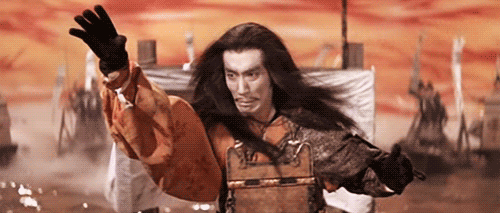
Production and Art Design: 9/10
Um...yeah. Of course this one’s high, not even a question. LOOK AT THIS GODDAMN MOVIE. No more needed here, it’s a 10/10, it’s gorgeous all around. Well...OK, maybe it isn’t perfect. And that all basically falls at the feet of The Black Hair. I meant it when I said that this was the weakest short. Because...yeah, it is. From the initial old-age make-up, to the weirdly plain kimonos worn by an extremely wealthy woman who should be able to afford more ornately patterned kimonos, this one was...weaker, atmospherically. Still great, mind you...but weaker. So, OK, maybe not perfect, but still good.
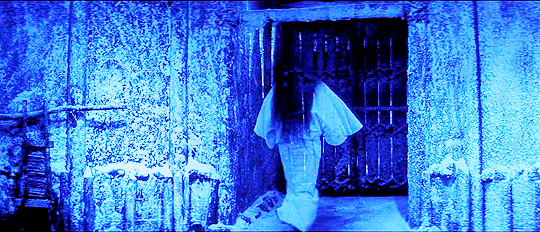
Music and Editing: 8/10
And the music by Toru Takemitsu is definitely memorable as well...but is the editing perfect? Eh. Not really. Sorry, Hisashi Sagara, I know you’re working with 1965 technology here, but it’s not...perfect. There was some work needed throughout each short, to be honest, but it was still all pretty solid. Music really holds up this category, though.

OK, Japanese spirits, you’ve got a 92%! Don’t haunt me.
I really want to go to Japan, by the way. Like, I’ve always been interested, and I never would’ve turned down a trip there, but I REALLY want to go to Japan one day. I’d love to visit a temple or a shrine (respectfully, of course), I’d love to experience the people and the atmosphere...I just think it’d be very cool, to be honest with you. And movies like this have only heightened that desire.
Man, I loved this one! What comes next in the pattern? Right, surrealist films written by well-known and influential directors! Cool, I’m pumped! Let’s jump right into it! What could go wrong?

March 14, 2021: The Holy Mountain (1973)
#Kwaidan#masaki kobayashi#怪談#anthology film#film review#movie review#fantasy march#user365#365 movie challenge#365 movies 365 days#365 Days 365 Movies#365 movies a year#usermichi#mygifs#my gifs
4 notes
·
View notes
Text
Nampō Roku, Book 6 (25): the Seat for an Hitotsu-mono [一ツ物] on the Daime-kiri is Explained in a Secret Teaching.

25) [On the daime-kiri, because there are various seats that may be occupied by things like an hitotsu-mono (一ツ物), one must conscientiously decide where to place them.]¹
In the case of the seat for an hitotsu-mono on the daime-kiri, there are various ku-den². [However,] if one only understands this [matter] in a general way, [that person] will [likely] make a mistake³.
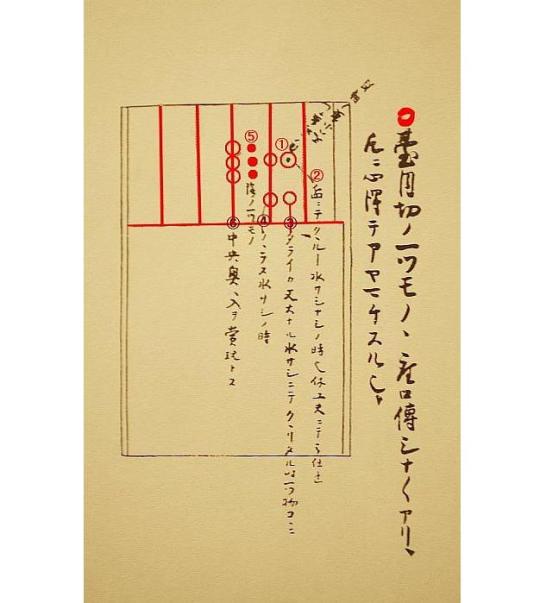
The kaki-ire [書入]:
① A yin hitotsu-mono, [displayed] without a tray⁴. And also, when a small tray is present, this [position] is used⁵.
② When a tray is used it should be a kuguri[-bon], because there is no mizusashi⁶.
③ When a tarai[-mizusashi], or [another] large mizusashi is being used that will cross [several kane], an hitotsu-mono is [displayed] here⁷.
④ When a mizusashi that does not cross [several kane, an hitotsu-mono is displayed here]⁸.
⑤ [These show] yin hitotsu-mono⁹.
⑥ The central [kane]: putting [the chaire] deeper is the way to treasure it¹⁰.
_________________________
◎ This is an extremely confusing sketch, produced either by someone who had a less than clear understanding of the sizes of some of the utensils involved; or, perhaps, as a way to restrict access to these teachings to the initiated (or those with access to a teacher). Also, the texts of the kaki-ire lend themselves to being misunderstood (especially by people who do not understand the details of the kinds of utensils being used).
Nevertheless, the sketch seems to have been produced as a way to illustrate the numerous ku-den that are associated with this matter (and so rendering verbal explanations unnecessary). It is possible that this drawing was added to the collection later, as an explanation of the statement that I have repeated (from the previous installment) at the beginning of this post, and so was the product of the Enkaku-ji scholars (rather than Nambō Sōkei or Rikyū).
¹This sentence is repeated here from the previous entry, since it appears to be the beginning of these introductory remarks.
²Daime-kiri no hitotsu-mono no za ku-den shina-jina ari [臺目切ノ一ツモノヽ座口傳シナ〰アリ].
Ku-den shina-jina [口傳品々] means there are various ku-den.
The ku-den are the points illustrated in the drawing (with additional information supplied by the kaki-ire).
This and the following sentences constitute the text that is written to the right of the drawing.
³Oyoso ni kokoro-ete ayamachi-suru nari [凡ニ心得テアヤマチスル也].
Oyoso ni kokoro-ete [凡そに心得て]: oyoso ni [凡そに] means only roughly, approximately; kokoro-ete [心得て] means to know*, or (ones) knowledge.
Ayamachi-suru [過ちする] means to commit a mistake, fall into error.
In other words, if ones experience is limited to practices based on the common or average sort of understanding, one is likely to make a mistake when displaying an hitotsu-mono in the daime-kiri setting. __________ *Kokoro-ete [心得て] is past tense, and signifies something that one (believes he) knows or understands before the fact -- that is, before he has been made aware of to the deeper teachings.
⁴In no hitotsu-mono bon nashi [陰ノ一ツ物盆ナシ].
Bon nashi [盆無し] means “there is no tray.”
In other words, when the chaire is a treasured piece that has not yet been paired with a tray, it is displayed in this position when it is a yin hitotsu-mono*.
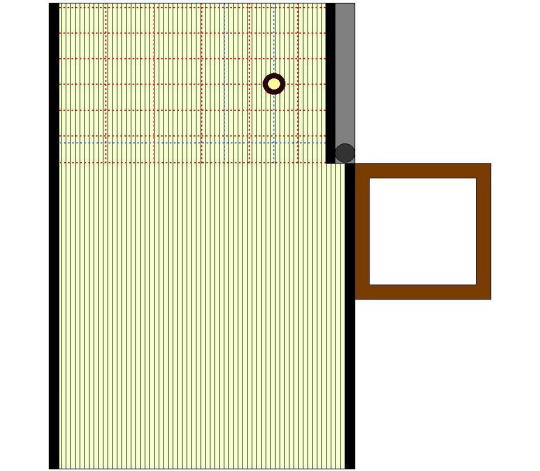
This part of this kaki-ire is possibly unrelated to the second part (and that is why I decided to separate them in the footnotes).
Regarding the absence of a mizusashi, this is seen in several of the ro-temae that are discussed in the Nampō Roku. While the precedent is always the gokushin-temae† (the ro-temae is generally based on the gokushin-temae -- even the modern schools hold that the ro-temae “is derived from the daisu”), the point that concerns us here is that things remain as they are until the end of the temae.
Whenever, during the temae, the host needs to cool the kama (in other words, the points at which cold water is traditionally added to the kama during the ro-temae), he does so by lifting a hishaku of water from the kama, holding it above the mouth of the kama for several seconds‡, and then returning it: this yu-gaeshi will be sufficient to restore the shōfū [松風] sound.
At the end of the temae, after placing the chaire, chashaku, and shifuku out for haiken, the host removes the koboshi and chawan to the katte, as always**. Then, at the time (in the modern temae) when the host brings out a mizu-tsugi, he brings out a small mizusashi (either the mage-mono kind, of a ceramic one of noticeably small size -- many look more like kashi-bachi with lacquered lids than mizusashi, and, indeed, are too small to be used as such during the temae). This is either placed within the kamae (in the usual spot occupied by the mizusashi, 9-me from the heri and centered between the two yū-yo [有餘]††), or it is placed on the mat that adjoins the daime, to the right of the ro‡‡ (as shown below).
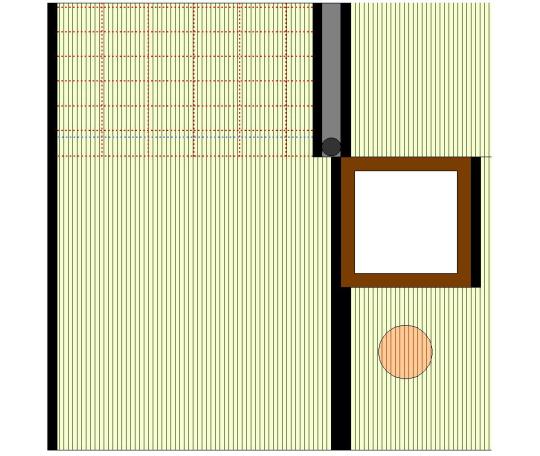
A hakobi-mizusashi [運び水指] (a mizusashi that is moved from the katte into the room) should never be filled more than 70%, to help prevent splashing.
Immediately after bringing the mizusashi out, its lid is opened, and then that of the kama, and two hishaku of cold water are added to the kama. Then the lids are closed, and the mizusashi is usually returned to the katte***.
The utensils that were inspected during the haiken should not be returned until the mizusashi has been removed (especially if the mizusashi had been placed to the right of the ro). __________ *This would mean an object displayed as an hitotsu-mono when it must be yin (in order to give a chō [調] value to the goza).
The goza should be chō when serving tea after dark, on occasions when tea is prepared as part of a Buddhist ceremony (in other words, when tea is offered to the Buddha), as well as on sad occasions (such as the memorial of a death).
†In the gokushin-temae, the mizusashi is not opened until the very end of the temae -- after the chaire, dai-temmoku, chashaku, and nagabon have been placed out for the guests to inspect. At that time, the mizusashi is opened and its water is used to clean the chasen in the kae-chawan; and, after that, two hishaku of cold water are added as a token replenishment of the kama. (The reader should remember that, in its original conception, the gokushin-temae was used to prepare a single bowl of koicha, which was offered to the Buddha. Thus the kama would not be emptied to the same extent as when serving tea to several guests.)
In the gokushin-temae, the haiken is performed immediately after the host has finished cleaning the temmoku, its dai, the chaire and chashaku, and the nagabon. These things are arranged on the nagabon, which is put out on the mat that adjoins the utensil mat, and the guests come forward to inspect the utensils in situ. While they are doing that, the host cleans the chasen in the kae-chawan and replenishes the kama. Then he lifts the nagabon back onto the utensil mat, and returns both the temmoku and chaire to their shifuku (tying the himo in a different, “locking” knot), and then the nagabon and other utensils are lifted back onto the ten-ita of the daisu.
‡The length of time is not fixed, and should be as long as possible (since the more the water in the hishaku cools before it is returned, the greater its effect will be -- especially if it is a large kama) without destroying the tempo of the temae.
**When removing the utensils, he should be sure to leave behind the hishaku and futaoki (with the hishaku resting on top of the futaoki) -- perhaps placing them on the left side of the kamae as shown below.
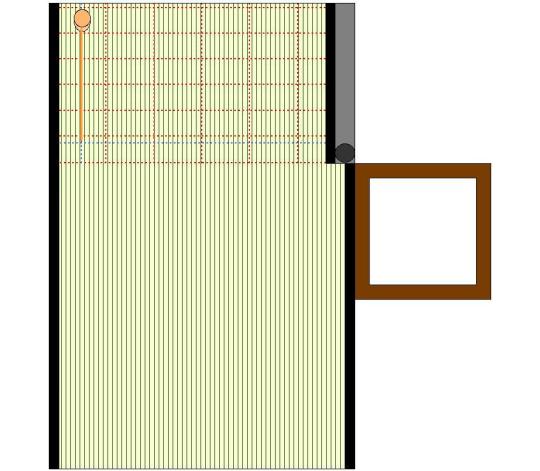
After adding water to the kama, the hishaku, the hishaku and futaoki may be left on the mat, in the same place as before.
††The two yū-yo [有餘] are the 5-bu at the far end of the kamae, and the 2-sun that extends across the mat from the naka-bashira.
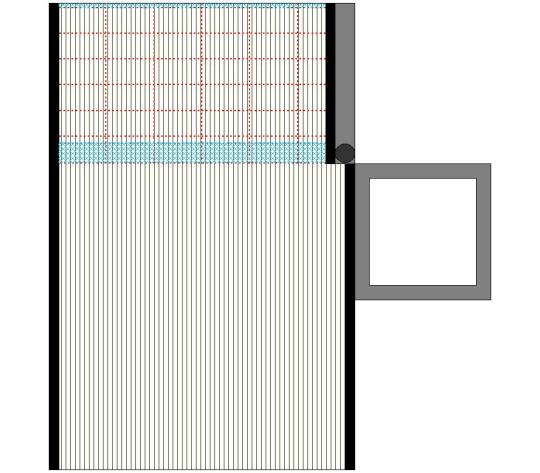
The distance between these two spaces is (of course) 1-shaku 4-sun, and the mizusashi is usually centered in that space.
‡‡This was the inspiration for the nagashi-date [流し立て, or 流し点て] (though that temae is usually performed in a 4.5-mat room, rather than in the daime setting). Nagashi-date is a temae, usually performed when there is only one guest (in a 4.5-mat room) -- the idea being that this arrangement allows the host and guest to sit facing each other, resulting in a more intimate sort of gathering. (Rikyū is said to have originated this temae when serving tea to Hideyoshi on the night of Tanabata [七夕].)
The mizusashi is placed to the right of the ro, with the futaoki directly in front of it. When brought out, the chawan and chaire (or other tea container) are placed on the utensil mat, on a diagonal and to the left of the ro (this is the same line on which the tea container and chasen rest during an ordinary ro-temae). The temae is otherwise the usual ro-temae, though the chawan is offered to the guest by lifting it out between the mizusashi and the ro. (While the modern schools usually restrict this temae to usucha, Rikyū seems to have created it as a koicha-temae, with usucha following during the same temae.)
***If the mizusashi was placed within the kamae, then it is not necessary to remove it (and during the Edo period, it became customary to allow it to remain there, so that the guests could inspect it before leaving the room); however, if it is placed on the mat beside the ro, then it must be removed immediately, so the guests can return the chaire, chashaku, and shifuku to the same place where they had been offered out by the host.
⁵Mata ko-bon no toki mochiiru [陰ノ一ツ物盆ナシ、又小盆ノ時用].
When the chaire is displayed on a ko-bon [小盆]*, the chaire is also located here.
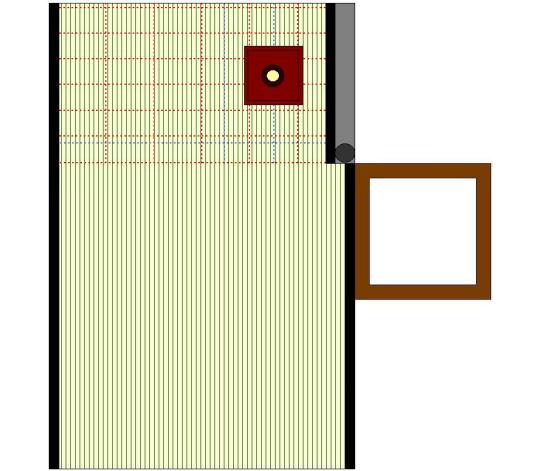
In the original sketch that is found in the Nampō Roku, the outer red circle is supposed to be the tray, which surrounds the black dot (that represents the chaire). While the sketch shows the bon-chaire as a yin hitotsu-mono, the relative sizes are completely unrealistic†. __________ *The ko-bon [小盆], as it was defined by Rikyū, should be 2-sun larger than the chaire on all four sides. The smallest of the ko-tsubo are 1-sun 9-bu in diameter, so the smallest ko-bon would be 5-sun 9-bu in diameter -- meaning that, when the chaire is centered on the yin-kane, the tray will contact the yang-kane on both sides, making it a kuguri-bon in this instance.
†When the chaire is displayed in this position without a tray, it is a yin hitotsu-mono. However, when a chaire is displayed like this, but resting on the kind of small trays known to have been used by Rikyū (and mentioned in his kaiki and other writings), it becomes a yang hitotsu-mono (because the tray will contact the yang kane on both sides of the chaire, thus making anything placed on the tray also yang).
Shibayama Fugen comments here that the bon-chaire could be a yin hitotsu-mono, but only if the tray were less than 4-sun 9-bu across.
Now, there is a small, dark-red Ikkan-bari [一閑張] tray that is 4-sun 9-bu in diameter, that was owned by Sen no Sōtan (who claimed that it had been handed down from Rikyū). Putting aside the fact that Hiki Ikkan [飛來一閑; ? ~ 1657] was a friend and contemporary of Sōtan’s (who is said to have been the one who encouraged the indigent Ikkan to take up this particular trade), and not known to have had any association with Rikyū, if the tray was 1-sun 5-bu larger than the chaire on all four sides, this tray would accommodate a chaire 1-sun 9-bu in diameter (many of the old Seto katatsuki produced during the second half of the fifteenth century were of this size).
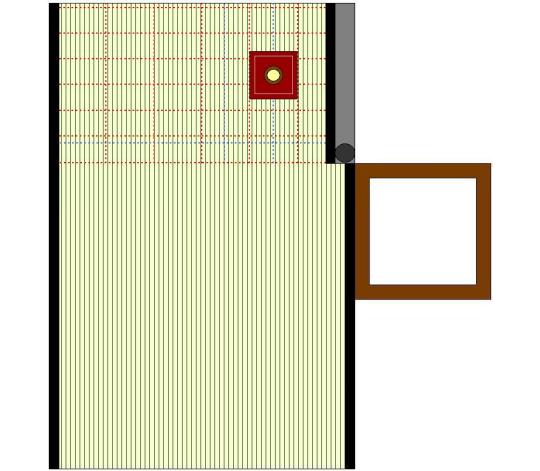
That said, while it is certainly possible that Rikyū was experimenting with this kind of thing (perhaps near the end of his life -- most of the things owned by Rikyū that came into the possession of Shōan and Sōtan were things that he was using during his last several years), there are no documents to support Sōtan's assertion, or that this kind of arrangement was ever used by Rikyū.
Furthermore, the second kaki-ire (which actually provides some additional input regarding the tray -- please see the next footnote) clarifies that, when a mizusashi is not present, the tray should be a kuguri-bon. This would seem to contradict any speculation that the tray being referred to here was intended to fit in between the kane (despite the impression created by the sketch).
⁶Bon ni te kuguru-koto mizusashi nashi no toki nari, Kyū kufū ni te kite-shidashita [盆ニテクヽルコト水サシナシノ時也、休工夫ニテ被仕出].
Kuguru [潜る] means to pass through, or pass across*, and refers to an object that crosses two kane of the same sort (i.e., one large enough to cross two yang kane, or two yin kane).
This is saying that, since there is no mizusashi, the tray should cross two yang kane, and so make the chaire yang.
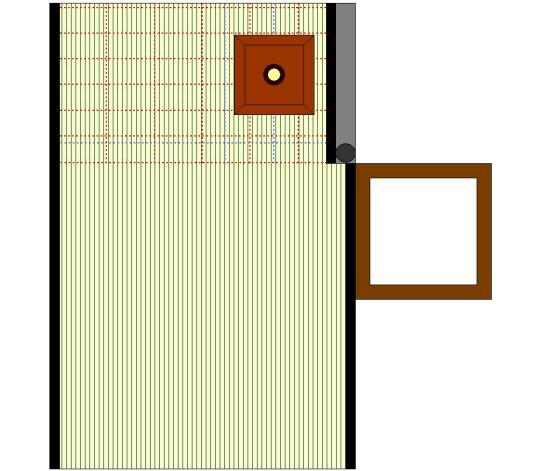
While Rikyū’s ko-bon (which was 2-sun larger than the chaire on all four sides) is technically a kuguri-bon (since a tray of this sort paired with even the smallest chaire would be larger than 4-sun 9-bu across), the Nampō Roku generally is referring to a larger tray when this expression is used -- such as a chaire-bon that adheres to Jōō’s specifications (3-sun larger on all four sides), as shown above.
Kyū [休] is the usual abbreviation of Rikyū's name.
Kite-shidashita [被て仕出した] means to bring into being, originate (literally, "undertook the creation of"). __________ *The word is commonly used to mean “dive” (as in, into the water) today, which confuses some readers of the Nampō Roku.
⁷Tarai ka mata dai-naru mizusashi ni te kuguri-taru toki, hitotsu-mono koko ni [タライカ又大ナル水サシニテクヽリタル時、一ツ物コヽニ].
Tarai [盥] means a basin. Containers of this sort used as mizusashi were usually around 8-sun in diameter (or slightly more).
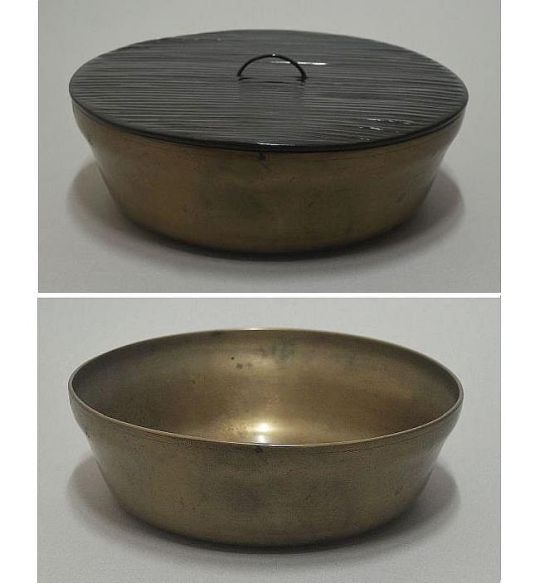
Dai-naru mizusashi [大なる水指] means a mizusashi of the larger sort -- one that is 5-sun 8-bu in diameter or larger. This kind of mizusashi is often referred to as a kuguri-mizusashi [潜り水指] in the Nampō Roku, because it crosses two yang kane (when centered on half of the mat -- as when placed beside a ko-ita furo, or a mukō-ro).
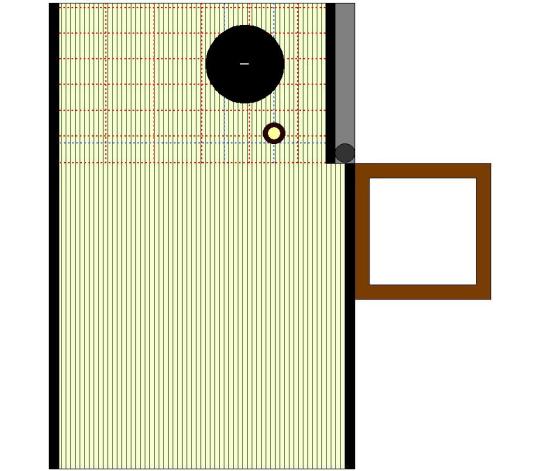
This sentence is saying that when the mizusashi is large enough that it crosses several kane (since it is placed 9-me from the heri, in this case it will cross two yin kane, and the yang kane in between), the chaire should be displayed in front of it, on the right-most of the two yin kane, as shown above. Because the mizusashi is yang (on account of its resting on a yang kane), the chaire will also be a yang hitotsu-mono (since it partakes of this quality of the mizusashi: the two are counted together as a single unit for the purpose of kane-wari).
⁸Kuguranu-mizusashi no toki [クヽラヌ水サシノ時].
Kuguranu [潜らぬ] means (the mizusashi) does not cross (several kane).
This would refer to the small mage-mono mizusashi (or mizusashi made of other materials of the same size) -- a mizusashi no larger than 4-sun 9-bu in diameter.
When the mizusashi is not a kuguri-mizusashi, an hitotsu-mono will be oriented as shown below.
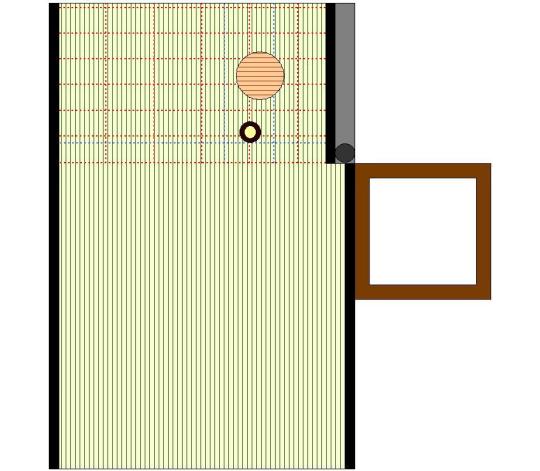
⁹In no hitotsu-mono [陰ノ一ツモノ].
The sketch shows three possible positions, which parallel the arrangements for the yang hitotsu-mono (see the following footnote): the chaire can be displayed near the front of the kamae, farther back, and even farther back (as indicated by the dots in the original sketch) -- with the deepest position indicating the greatest degree of respect for the chaire.
Presumably these arrangements were supposed to be done with a mizusashi present*; and Shibayama Fugen states that his source also indicated that the chaire is centered on the second, third, and fourth horizontal kane. While all of this works nicely when the chaire is arranged on the central kane, the deepest of these is simply not possible if a mizusashi is present†, when the chaire is being displayed on the yin-kane.
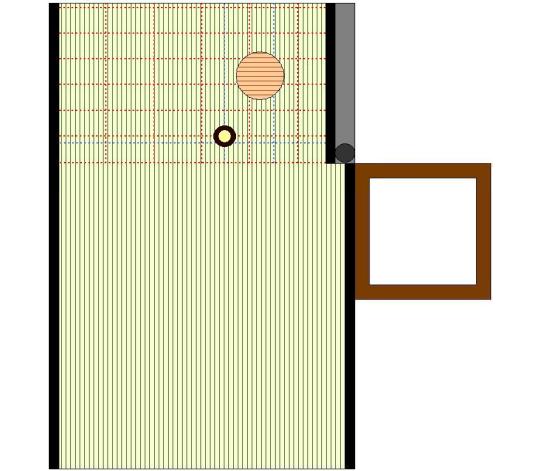
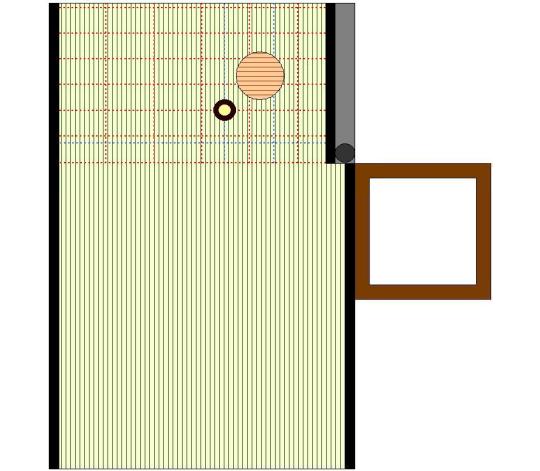
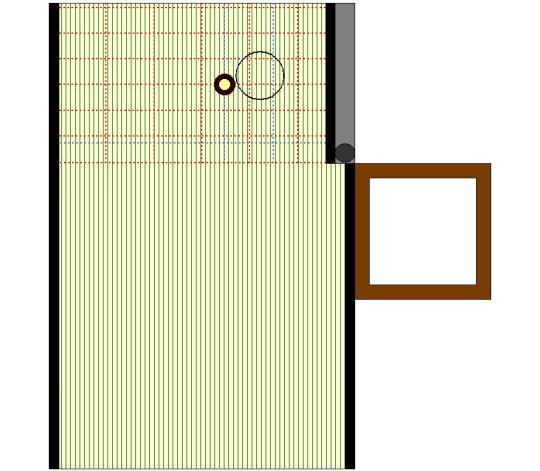
In the above sketches, the shallow arrangement is at the top, and the deepest is on the bottom‡. Here a small (4-sun 9-bu diameter) mage-mono mizusashi is shown, though even in this case, the deep arrangement would be too close to the mizusashi to be practicable**. __________ *Since otherwise, the chaire would presumably have been displayed on the part of the mat usually occupied by the mizusashi (at least according to the other kaki-ire).
†Though nothing explicitly states that a mizusashi is used -- on this, or on any of the other occasions when a chaire is displayed as an hitotsu-mono (and, indeed, none is shown anywhere in the original sketch) -- mention is specifically made when a mizusashi is not to be used; and, in that case, the chaire is displayed in the part of the kamai that is usually occupied by the mizusashi (as in kaki-ire ① and ② -- since both of these notes address the same mark on the original sketch).
While both Shibayama Fugen and Tanaka Senshō have previously cast doubt on the historical authenticity of arranging the mizusashi 9- (or 11-) me from the heri, suggesting that this was a more modern innovation, their assertions appear to have been based on the order in which this teaching came to light (usually believed to have been from a poem in the Chanoyu hyaku shu [茶湯百首], which is popularly ascribed to Rikyū, and which first became known to the interested public around the middle Edo period). However Rikyū also mentions this placement in several of his densho -- and these documents are consistent in their explanations, despite their having been preserved in vastly different places, and usually secretly (often unknown to the person in whose archive the document was housed), since shortly after they were written. Because of this constancy, we must accept that this placement for the mizusashi had been fixed upon, by Jōō and Rikyū (since the daime-kiri was a joint project), shortly after the time when the daime-kiri was created (at the time when the fukuro-dana was removed from the kamae -- which was probably attempted not so long after the setting was originally devised, as a wabi modification).
The point in time at which any given teaching has come to light usually has little to do with when it was actually formulated, and introduced into more or less general practice. Unfortunately, the conservative nature of chajin often makes it difficult for them to put aside teachings (as they were previously understood at the time when the chajin was training), and replace them with more historically accurate ways of doing things (we must remember that, taking the beginning of chanoyu as it is now understood as occurring with the creation of the cha-kai [茶會] during Jōō’s middle period, we are talking about close to 500 years of development over which it has continued to evolve and change). In Japan, this has often resulted in attacks, even on the writings of Rikyū himself -- and often initiated by the very people whom one would suppose would be the most adamant about protecting his legacy.
It is equally true that Nampō Roku scholars often remain (or actively keep themselves) insulated from everything but the particular collection of texts with which they are associated -- even when much necessary information cannot be found in those texts. As I have written many times before in this blog, the teachings of Rikyū cannot be found in any single collection, including, somewhat paradoxically, in his own writings. Rather, we must look to the cycle of the Hundred Poems, the Three Hundred Lines, Rikyū’s densho, and the Nampō Roku -- while ignoring the machi-shū writings that sought to undermine Rikyū’s teachings and replace them with the ideas of Imai Sōkyū and his followers: it is not that everything from the early days is equally valid, but that we must use discretion, at least if our purpose is to arrive at a good understanding of Rikyū’s own teachings.
‡As the most likely time when the yin hitotsu-mono arrangements would be used would be after dark, one might wonder whether or not the deepest placement might make the chaire too difficult to see (even if it were possible to arrange the kamae like that -- if a sufficiently narrow mizusashi, much smaller than the small mage-mono mizusashi, could actually be found). We must remember that the kamae is illuminated by a te-shoku [手燭], whose flame is centered between the mizusashi and the kama. That would throw at least a partial shadow on the chaire, which would be reprehensible. It is possible, therefore, that the dot indicating the deep version of the yin hitotsu-mono was added to the sketch in error (with the artist focused on this being a parallel case to the yang hitotsu-mono, rather than on the mechanics of actually creating this kind of arrangement).
**While both Shibayama Fugen and Tanaka Senshō devote a certain amount of their commentaries to a discussion of all of the different ways that an hitotsu-mono can be displayed within the kamae, both of these scholars completely ignore these three yin hitotsu-mono arrangements in their comments (Shibayama does include a small sketch, but his sketch shows dots arranged on a vertical line, and is missing any suggestion of a mizusashi) -- suggesting that they, too, are unsure about them (and, especially, about the deep version).
As discussed above, it is possible that the sketch was miscopied, or inadvertently modified at some point in time. The problem is that the sketch, as it is shown above, was taken as the absolute authority, without any thought being given to things (like the mizusashi) that were not included in the drawing.
¹⁰Chū-ō, oku [h]e ire wo shōgan to su [中央、奧ヘ入ヲ賞玩トス].
Oku [奧] means deep (in the sense of deep within an enclosure).
Shōgan to su [賞玩とす]: shōgan means to treasure, appreciate, revere, respect; to su [とす] is a contraction of to suru [と爲る], meaning “to do.”
Here, the chaire is displayed on the central kane, the kane of honor, meaning that this series of three placements is the way to show the deepest respect for the treasured chaire -- with the reverence increasing as the chaire is moved deeper into the kamae.
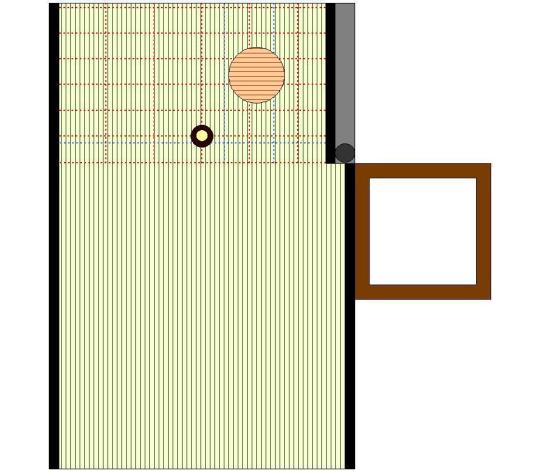
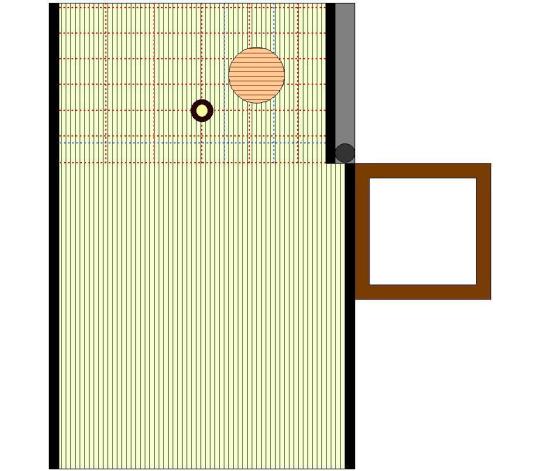
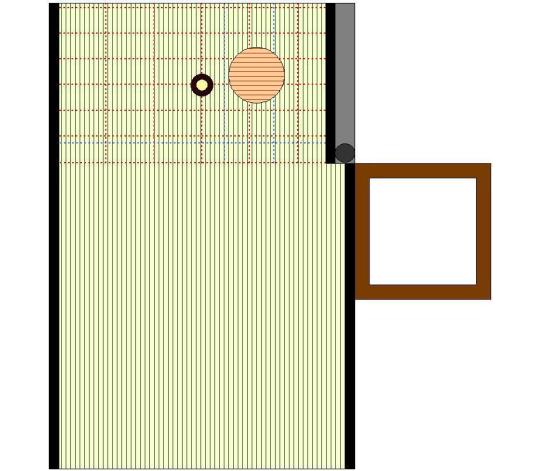
At the top, the chaire is displayed near the front of the kamae; in the middle, it is placed a little deeper; and at the bottom, it is deepest. In these sketches, the large size of mage-mono mizusashi has been depicted. __________ *Measuring 8-sun 5-bu in diameter.
2 notes
·
View notes
Text
March 13, 2021: Kwaidan: The Black Hair (1963)
Three hours of Japanese ghost stories. OK. How do I do?

Time is always a complicated mistress for me, so I really have to plan this accordingly. OK, let’s see, what do I know about Kwaidan? Well, it’s a Japanese anthology film...ahhhhhhhh, there it is!
OK, solution discovered! This film is broken up into four disparate short stories, so we’ll be tackling each one one at a time. Four shorter posts, one full movie! Nice. Now, normally, I’d go through a bit of an introduction, but I don’t know much about this film, or the short movies contained within. So, instead, let’s talk Japanese mythology.
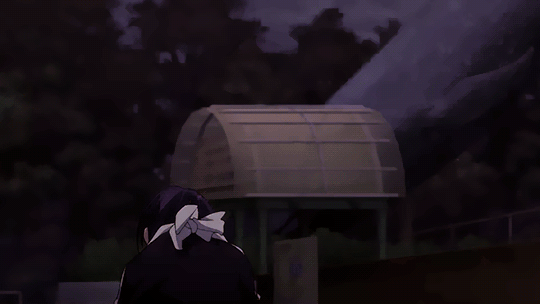
Hate to admit it, but basically all of my knowledge of Japanese gods and folklore comes from anime. Which isn’t the worst source, necessarily...but it’s definitely not the actual source. I’ve seen Noragami Season One, I’ve watched a button of other slice-of-life and folklore-based anime, so I know a little bit. The GF is far more adept (she’s the one who got me into Noragami, amongst other things), and she’ll be watching this movie as well, when she can.
So, I’m a relative novice when it comes to these things. What makes this more interesting is the fact that these stories are based on somewhat more contemporary sources, which means that they may not borrow from Japanese mythology much at all, outside of shared themes and morality. Sound familiar?

Yeah, that basically describes Ugetsu Monogatari, which I covered a few days ago (here, here, and here, in that order). While it’s based off of a book, it shares elements seen in a lot of old Japanese folklore and traditional beliefs. Don’t needlessly pursue material goods and fame over happiness, and don’t fuck ghosts. Yeah, that’s mostly what I learned from that one.
Kwaidan, which literally means “ghost stories” in Japanese, came out over a decade later, is in color, as was directed by Masaki Kobayashi, and this is the only movie of his that I’ve ever heard of, so that’s something. In any case, I’m excited for this one! As excited as I am...worried. Because I have absolutely no idea what I’m in for. LET THE THREE HOURS COMMENCE (broken up into four palatable pieces).

The movie segments are as follows:
The Black Hair (黒髪, Kurokami)
The Woman of the Snow (雪女, Yukionna)
Hoichi the Earless (耳無し芳一の話, Miminashi Hōichi no Hanashi)
In A Cup of Tea (茶碗の中, Chawan no Naka)
We’ll start with The Black Hair, which is giving major “The Ring” vibes, just as a name. We’ll see if I’m right about that, I guess! SPOILERS AHEAD!!!
Recap (1/4)
We start it all off with the Criterion Collection logo, and then...ink.

Ink of black, red, and blue, dropped into water set against a white background, is seen cascading down the screen over the opening credits. The titles of the four short films are also introduced, as the ink colors are mixed over a mostly silent background. And once the end, we begin with our first story.
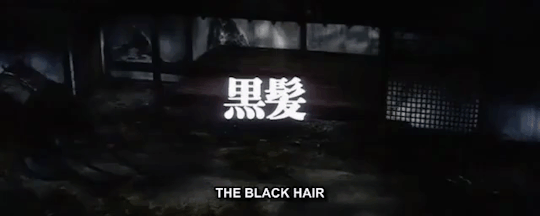
The Black Hair
There’s a dilapidated estate, and as we travel through it, all of the background noises are amplified, and a set of doors opens, seemingly with the breeze. We enter, and a narrator tells us that there was a samurai that lived in old Kyoto, brought to financial ruin by the workings of his former master. To regain financial and social status, he’s decided to leave his wife behind. We join them now.

The samurai (Rentarō Mikuni) leaves his sobbing wife (Michiyo Aratama), refusing to rot away in the estate, no longer dilapidated, as we’ve clearly gone back in time. Despite the desperate pleading of his wife, the samurai leaves Kyoto, and cruelly shoves his wife aside, hitting her with his sheathed sword at one point. So, yeah, he’s a dick. And his quest for fortune will almost certainly be his ruination. Like I said, certain shared themes.
That’s made even clearer by the next scene, in which the samurai is now married to a wealthy woman (Misako Watanabe) that looks very much like the woman from Ugetsu, smudgebrows and...impressively long hair, GODDAMN!
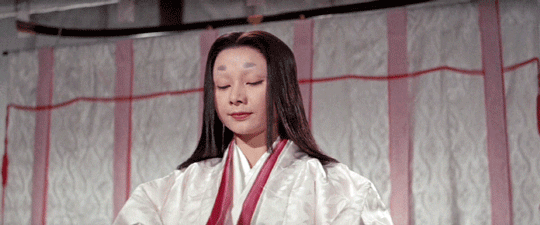
The wealthy family of said daughter welcomes the samurai into the family, and he provides for her while also enjoying a higher social status as a result of the marriage. One day, he brings her to his post, and we clearly see that she’s in love with material possessions, moreso than her husband. Which, yeah, sounds familiar.
Looks like the samurai’s also starting to realize this, and he reminisces about his first wife, presumably still Kyoto. Yeah, bud, ya fucked up, don’t be a dick. Also, I assume that it attracts ghosts, since...you know, this is a ghost story. But yeah, he realizes that he still loves his first wife, patient and loving, as opposed to his cold and selfish second wife.

And so, in his heart and mind, the samurai returns to see his first wife. Meanwhile, in his new life, the samurai is constantly haunted by memories of his first wife. It interferes with his archery on horseback during an exhibition with a competitor. Dude’s fucked up.

Meanwhile, the spoiled second wife is bored, coldly dismissing her handmaidens while waiting for her new husband to attend to her. She happens upon him, asleep next to a scroll. She tries to kiss him, but the great idiot turns her away. She slaps him, upset at both his own selfish ways, and his still-lasting devotion to his wife.
He gives up on pleasing her after this, and decides to officially return to his first wife to make amends for not appreciating her in the first place. However, despite this, his duty as a samurai in the region still lasts a few years, and he’s unable to return to his first wife until that point. And when he does, the place is mostly still OK, but somewhat wrecked on the outside.
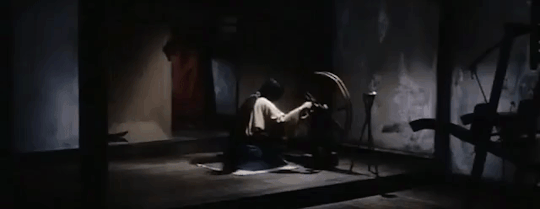
Yet, despite this, there she is, working at her loom and spinning wheel. The two are happy to see each other, and the samurai notes that she hasn’t left his mind, and apologizes for being a dick. He also notes that she hasn’t aged a day. Yeah, she’s 100% a ghost, fuck.
Anyway, he begs his definitely ghost-wife for forgiveness, which she quickly and enthusiastically gives. She even says that she never felt worthy for being his wife, and that she doesn’t deserve love from someone of his station, as compared to her own. Goddamn, dude really is a dick for leaving this ACTUAL SAINT of a woman.

He pledges to make amends, and that nothing will ever separate them again. He notes that her hair smells the same as it did before. The same glossy black hair, he notes. He compliments her looks as they kiss. And yeah, real talk, she is a GORGEOUS woman. Again, dude’s a dick. But whatever, at least they’re together again.
And the samurai’s love QUICKLY gives way to horniness, as they make their bed in the room that they “first made love in”, according to him. They pledge to be together for the present and the future, and the swordsman falls asleep with his wide watching over him.
The sun rises the next day, and the samurai wakes up next to his wife, and sees her long black hair...
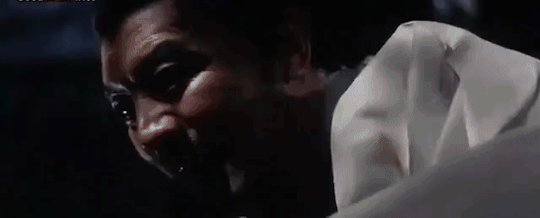
AAAAAAAAAND it’s a corpse. It’s her dead fuckin’ body, and the hair’s still attached. Saw that coming...although I didn’t think my whole “don’t fuck ghosts” joke would come true that quickly.
AND THEN THE HAIR FUCKING ATTACKS HIM AND DRAINS HIS LIFE FORCE, WHAT IN THE NINE FUCKS

Yeah, no, he’s rapidly aging, and he tries to escape the estate, now obviously completely dilapidated. The now elderly samurai does get out of the estate...but he doesn’t escape.

Damn. Story Number One concluded.
Weird-ass story, in a way, but very well-shot. as it finishes, the GF begins to elucidate on the actual cultural relationship of this story. Here she is now, actually.
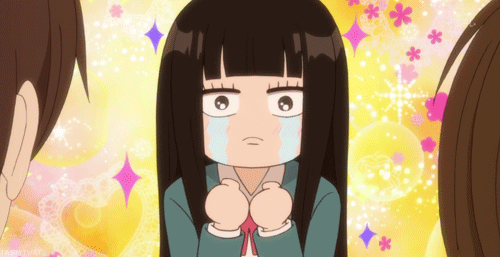
Iridescent. Anyway, she told me about onryō (怨霊), vengeful spirits that come to exact revenge on those who committed wrongs on them or in general, taking their spirits from their dying bodies. Apparently, husbands wronging their wives and getting fucked over by the spirits is a common occurrance. Neat.
It’s also possibly a reference to the yōkai called the futakuchi-onna (二口女). That one, I already knew about. She’s the two-faced woman with her second face hidden behind her long hair, draped and kept down. Said hair is also prehensile! And for the record, I only knew about her because of this:

Yup, Mawile is a Steel/Fairy type Pokémon based on the futakuchi-onna. Neat, huh?
Anyway, that’s the end of the first story...shall we move on to the second one? Next up, Kwaidan: The Snow Woman! See you there!
#kwaidan#masaki kobayashi#怪談#Michiyo Aratama#Misako Watanabe#Rentarō Mikuni#fantasy march#user365#365 movie challenge#365 movies 365 days#365 Days 365 Movies#365 movies a year#mygifs#my gifs
5 notes
·
View notes
Text
Nampō Roku, Book 5 (52): Midare-kazari [亂飾] for the Large Maru-bon¹, [One] of Three [Arrangements].

52) Dai maru-bon midare-kazari mitsu no uchi [大丸盆亂飾三ツ之内]².
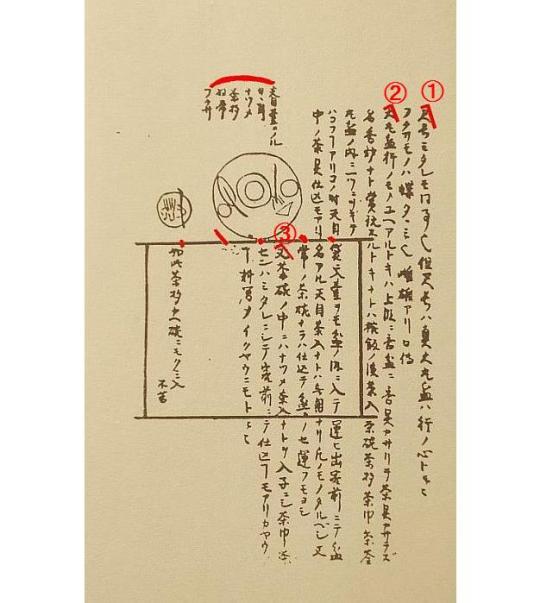
[The writing (above the daisu) reads³: temmoku dai ni noru (天目臺ニノル)⁴, sasa-mimi (サヽ耳), natsume (ナツメ), chashaku (茶杓), habōki (羽帚), fukusa (フクサ); (between the ten-ita and the ji-ita, beneath the kae-chawan) kaku no gotoki chashaku kae-wan ni mo kumi-iri, kurushi-karazu (如此茶杓・カヘ碗ニモクミ入、不苦)⁵.]
The kaki-ire [書入]⁶:
① This is the same as in the midare arrangement displayed on the shaku-naga[bon]. However, the shaku-naga is shin [眞], while the dai maru-bon has the feeling of gyō [行], so it is said⁷.
The fukusa-mono is folded [to resemble] a butterfly. There are female and male [versions]: [these details are discussed in a] ku-den⁸.
② Because the dai maru-bon is a gyō [行] utensil, on certain occasions when the incense utensils are displayed on a kō-bon [香盆] on the upper level [of the daisu], incense utensils should not be displayed [simultaneously]⁹.
[For example,] when showing appreciation to a famous incense burner (and on other occasions of that sort), following the meal a [dai] maru-bon is brought out on which are placed the chaire, chawan, chashaku, chakin, [and] chasen -- carried out as a single unit¹⁰.
On this occasion, the temmoku [tied] in its fukuro, ,[resting on its] dai, may also be on the tray when it is carried out¹¹. Or else the tea utensils may be [brought out one by one and] arranged on the tray, while the guests are still in the room¹².
Things like a temmoku or chaire that have a name should never be [included] in [this kind of practice]: ordinary utensils should suffice¹³. And again, if it is an ordinary chawan that has been prepared, it is likewise acceptable for it to be resting on the tray when [the dai maru-bon] is carried out.
③ Also, a natsume [or other kind of] chaire may be [placed] inside the chawan. When [the natsume] is stacked inside [the chawan], the chakin and chasen should be [arranged on the tray] separately¹⁵.
There is also the case where this is all done in front of the guests -- with the objects [finally] arranged as shown [in the sketch]¹⁶.
_________________________
◎ This arrangement, and the other two* that constitute this series of three midare-kazari, were a legitimate part of Jōō's original collection.
The fact that no incense things are included on the tray in the present arrangement should not confuse the reader†, since this is the way the things were arranged on the tray when it was brought out after the appreciation of incense had been concluded.
This entry provides us with a good, contemporary description of how the Shino family conducted their gatherings‡. __________ *Unfortunately, the page on which the third of the three arrangements was drawn was torn when the manuscript came into Tachibana Jitsuzan's hands, meaning that it is not possible to determine the precise kazari that it depicted (though, most likely, it was another form of cha・kō kazari [茶・香飾], like the second one).
†This final section of the first part of Book Five is, as has been mentioned before, devoted to the cha・kō [茶・香] arrangements employed by the Shino family during their incense-appreciation gatherings (at which tea was also served -- during the goza), and the second kaki-ire explains one way that this was done: the dai maru-bon was brought out from the katte (with the tea utensils arranged in a manner resembling what is shown in the sketch) after the appreciation of incense, and the meal, had been concluded (since, at their more formal gatherings, the Shino apparently felt it was best not to mix the tea things with the incense things at the beginning of the shoza), indicating that tea would be served when the guests returned from the naka-dachi.
Unlike the modern (and ancient) gaming format, the Shino family preferred to focus their gatherings on the smelling of just one or two varieties of kyara [伽羅] incense as a way to enter samadhi (via the purification of the olfactory sense). The preparation and taking of tea, then, was completely aligned with their objectives (since tea is best appreciated when host and guests have all entered the state of samadhi -- while the intervening meal would serve to protect the stomach from being overwhelmed by the tea).
Unfortunately, the history of chanoyu was rewritten in the Edo period, with the objective being to emphasize the “purity” of the various arts. Thus, since the Shino family (or, rather, the group of Japanese adherents who carried on the name after the original Korean line became extinct) was most closely associated with incense (Shino Sōshin had been Yoshimasa's incense master -- an idea appropriated by the machi-shū practitioners of chanoyu who, later, asserted that Shukō had been Yoshimasa's tea master, even though it is indisputable that Yoshimasa learned chanoyu from Nōami; meanwhile, the original Shino family continued to do things according to their own understanding of the practice of chanoyu on the continent), their impact on chanoyu (it appears that Jōō actually learned his basic techniques by observing what the Shino were doing) was emphatically ignored.
‡Perhaps the text of the second kaki-ire was written by Jōō himself.
¹Large maru-bon.
The dai maru-bon [大丸盆] measured 1-shaku 3-sun in diameter, and was the largest of the six meibutsu trays (selected by Nōami for Yoshimasa to use) that could be lowered to the mat during the temae. In fact, the orientation of the daisu on the utensil mat was determined by this tray: the dai maru-bon was placed so that its front edge touched the middle of the mat, and the daisu was then placed so that it touched the far side of the tray. This left a space of 4-sun 5-bu on the far side; and the host sat 1-sun below the middle of the mat*.
The original tray featured a design of karabana [唐花], “Chinese flowers,” within a doubled-vine (futae-zuru [二重蔓]) arabesque, in mother-of-pearl inlay. The tray, as mentioned above, measured 1-shaku 3-sun in diameter, and had a perpendicular rim (meaning that the diameter at the top and at the base was the same, making the tray very easy to position).
This tray could have come from China, though Korea had been renowned, since ancient times, for the quality of the mother-of-pearl inlay produced there (and many of the greatest examples of this craft preserved in collections in Japan originated in Korea).
The original tray was destroyed during the Ōnin wars, along with the rest of Yoshimasa's collection, and subsequent examples were based on the kagami-nuri [鏡塗] (mirror-finish lacquer) example that Haneda Gorō [羽田五郎; dates unknown, though he was active during the second half of the fifteenth century] produced for Yoshimasa after the fire. __________ *One-sun being the width of the heri on an ordinary tatami.
This seating of the host on one half, and placing the utensils on the other is to be understood as the daisu and the other utensils occupying one half of the mat, while the host occupies the other half. In the early days (before the room came to be covered with mats), a half-mat square was considered suitable for one person's seat (while a nobleman occupied a full-length mat by himself).
²Dai maru-bon midare-kazari・mitsu no uchi [大丸盆亂飾・三ツ之内].
“The large maru-bon, [with] midare-kazari・[one] among three [arrangements].”
As has been explained before, midare-kazari [亂飾] means that the utensils are distributed -- seemingly at random -- across the face of the tray.
This arrangement is for a gathering when two varieties of koicha will be appreciated.
³This list of the objects displayed on the tray is simply a list. It does not indicate the order of the objects on the tray (though some scholars appear to have taken it in that way, leading to hopeless confusion).
The things are arranged on the tray as shown below:
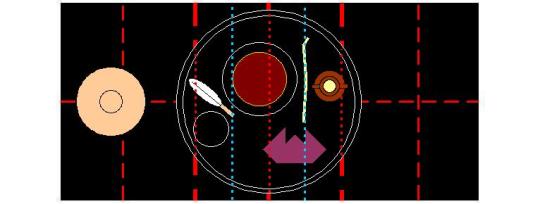
The temmoku overlaps the central kane by one-third, while the sasa-mimi and natsume contact the yang-kane to the right and left. The chashaku is placed on the yin-kane to the right of the central one, while the handle of the habōki only contacts the yin-kane on the left (thereby gathering the natsume with the temmoku, just as the fukusa also connects the chashaku with the temmoku).
Only the sasa-mimi is left by itself, indicating that it will be used to serve tea last -- not a mark of inferiority, but, as discussed previously (in the arrangements that focused on the use of this tea container that was a feature of the machi-shū practice), so that the guests could focus on the tea container.
The dai maru-bon will not be lowered to the mat until the last part of the temae, so that both the dai-temmoku and the sasa-mimi may be stood on the tray during the preparation and service of the second variety of tea. (The habōki is used to clean the dai maru-bon.)
⁴Temmoku dai ni noru [天目臺ニノル].
“The temmoku, mounted on [its] dai.”
⁵Kaku no gotoki chashaku kae-wan ni mo kumi-ire, kurushi-karazu [如此茶杓・カヘ碗ニモクミ入、不苦].
“If, in this way, the chashaku is also included with the kae-[cha]wan, there is no problem.”
⁶The complete Japanese texts of the kaki-ire are:
① shaku-naga midare mo onaji-koto nari, tadashi, shaku-naga ha shin, dai maru-bon ha gyō no kokoro to iu-iu, fukusa-mono ha chō-tatami nari, mesu-osu ari, ku-den
[尺長ミタレモ同事也、但、尺長ハ眞、大丸盆ハ行ノ心ト云〻、フクサモノハ蝶タヽミ也、雌雄アリ、口傳];
② dai maru-bon gyō no mono no yue, aru-toki ha jōdan ni kōbon ni kō-gu kazarite, cha-gu kazarazu, mei-kōro nado shōgan-suru toki nado ha, wanban no ato, chaire・chawan・chashaku・chakin・chasen maru-bon no uchi ni hitotsu ni okite hakobu-koto ari, kono toki temmoku fukuro ni iri, dai wo mo bon no uchi ni irete hakobi-dashi, kyaku mae ni te bon naka no cha-gu shikomi mo ari, mei-aru temmoku・chaire nado ha mu-yō nari, bon no mono taru-beshi, mata tsune no chawan nara ba shikomite, bon ni nose hakobu mo yoshi
[大丸盆行ノモノユヘ、アルトキハ上段ニ香盆ニ香具カサリテ、茶具カサラズ、名香爐ナト賞玩スルトキナトハ、椀飯ノ後、茶入・茶碗・茶杓・茶巾・茶筌丸盆ノ内ニ一ツニヲキテハコフコトアリ、コノ時天目袋ニ入、臺ヲモ盆ノ内ニ入テ運ヒ出、客前ニテ盆中ノ茶具仕込モアリ、名アル天目・茶入ナトハ無用ナリ、凡ノモノタルヘシ、又常ノ茶碗ナラハ仕込テ、盆ニノセ運フモヨシ];
③ mata chawan no naka ni ha natsume・chaire nari, ireko ni shi chakin・chasen ha midare ni shite, kyaku mae ni te shikomi-koto mo ari, kayō no koto ryōken shite ikuyō ni mo to iu-iu
[又茶碗ノ中ニハナツメ・茶入ナリ、入子ニシ茶巾・茶センハミタレニシテ、客前ニテ仕込コトモアリ、カヤウノコト料簡シテイクヤウニモト云〻].
⁷Shaku-naga midare mo onaji-koto nari, tadashi, shaku-naga ha shin, dai maru-bon ha gyō no kokoro to iu-iu [尺長ミタレモ同事也、但、尺長ハ眞、大丸盆ハ行ノ心ト云〻].
“Shaku-naga midare is the same thing [as this]. However, the shaku-naga is ‘shin,’ [while] the dai maru-bon gives a ‘gyō’ feeling, so it is said.”
⁸Fukusa-mono ha chō-tatami nari, mesu-osu ari, ku-den [フクサモノハ蝶タヽミ也、雌雄アリ、口傳].
“The fukusa-mono is folded [to resemble] a butterfly. There are female and male. There is a ku-den [related to this matter].”
Both Shibayama Fugen and Tanaka Senshō express bewilderment over this matter of this chō-tatami-kata [蝶疊み方] (Shibayama going so far as to state that he can make no sense of the drawing -- though the lack of detail in the drawing suggests that Tachibana Jitsuzan, too, had no idea of what to do) -- Tanaka, however, speculates that it might be the same thing as the way that the fukusa is folded in one of the secret temae taught by his school*. The actual tatami are shown below -- on the left is the mesu [雌] (female) chō-tatami [蝶畳み], while on the right is the osu [雄] (male) chō-tatami-kata [蝶畳み].

Be that as it may, the ku-den refers to both the two forms of the chō-tatami-kata [蝶畳み方] (how to fold the fukusa), and the occasions when the two different versions should be used.
As the first step in both of these, the fukusa is folded diagonally (as usual, before folding it for the temae), with the wa-sa [輪差] (the side that is folded rather than stitched, marked “ⒷⒸ” on the following sketches) on the right, and laid flat on the tray.
The mesu [雌] (female) form of the musubi is shown below (note that the corners “Ⓒ” naturally separate slightly when brought up, thus no special effort has to be made in this respect).
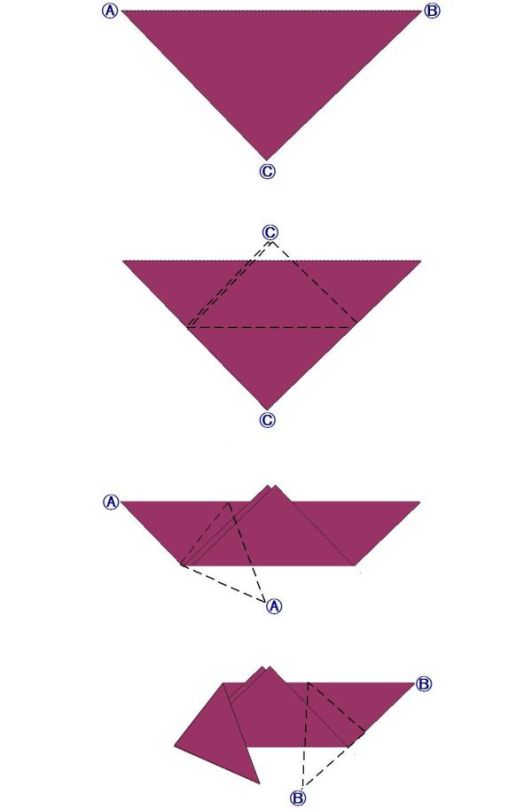
And the osu [雄] (male) form is folded as shown below.
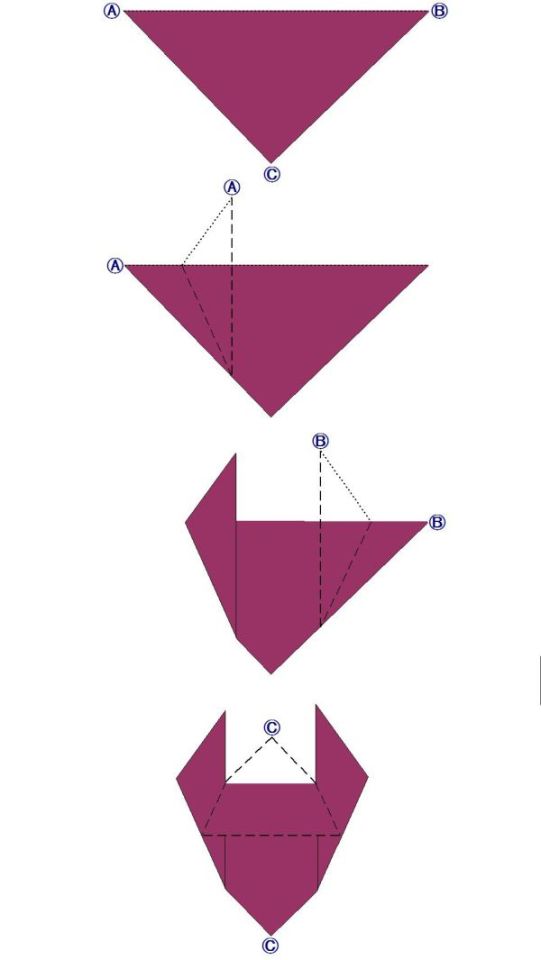
◎ The actual purpose of folding the fukusa in these ways is to keep the part of the cloth that will be used to wipe the tea utensils perfectly clean -- no matter how long the fukusa remains resting on the tray in this way -- by folding other parts of the fukusa over it.
◎ To lift the fukusa from the tray, the corner representing the tip of the right wing (“Ⓑ”) is picked up with the thumb below and the first finger above the corner. The fukusa will then fall into the usual triangular shape that can then be folded in the ordinary manner, before being tucked into the futokoro of the host's kimono†.
Finally, the ku-den concludes with the teaching that the fukusa should be folded in the “osu” form (osu, which means “male,” is yang) when tea will be served during the daytime, and in the “mesu” form (mesu, “female,” is yin) when tea will be served at night.
These ways of folding the fukusa probably originated with the Shino family, for the purpose indicated here.
The reader is asked to understand that while I have colored the fukusa purple, during the period when Jōō wrote his manuscript the temae-fukusa was made of Chinese donsu , of whatever color and pattern the host favored (and could afford), and its size was determined by the native width of the cloth‡. __________ *This is not possible, however, since this is not a way that the fukusa can be folded during a temae. Rather, it is loosely folded on the tray in such a way that it can be easily picked up (and then refolded and so tucked into the futokoro of the host's kimono at the beginning of the service of tea). Folded in the manner shown, the fukusa could not be used to do anything.
†It must be remembered that folding the fukusa in the presence of the guests was a practice initiated by Rikyū. Theretofore, the fukusa was folded in the katte, and inserted into the futokoro, from where it was taken out to be used, and then returned immediately afterward.
Rikyū may have taken his inspiration from Shino Shōha [志野省巴; 1502 ~ 1571], who was one of his friends. Originally Rikyū folded the fukusa at the very beginning of the temae, immediately after the sō-rei. This would be similar to what is done here. (He later decided to follow Furuta Sōshitsu's suggestion that the folding of the fukusa be delayed until it was time to wipe the chaire, so that it would be cleaner. Oribe, meanwhile, took this idea from his own practice of using the little furoshiki in which a gift container of matcha was tied as the temae-fukusa when serving its tea.)
‡Purple fukusa of the size used today were created by Rikyū -- that is true -- not as a temae-fukusa, but as a furoshiki [風呂敷] (a wrapping cloth) in which a small natsume of gift tea was tied before it was sent off to the recipient. Purple was used because silk of this color was the most difficult (and so the most costly) variety of silk produced in Japan (at that time, the trade embargo with the continent was still in effect).
This kind of wrapping-cloth was first used as a temae-fukusa by Furuta Sōshitsu, when he unexpectedly received a gift of tea, from Rikyū, while officiating at a chakai. Deciding to share the tea with his guests (since it would never be fresher than when first received), he brought the natsume (tied in the little purple wrapping-cloth) into the tearoom. But, since he did not have a second fukusa (to keep them clean, the host usually only prepared as many fukusa as he would need for any given gathering; nevertheless, the rule was that a new fukusa had to be used for each different variety of tea that was being served at the gathering), Oribe suddenly got the idea to fold the wrapping cloth, and use that as a temae-fukusa to clean the natsume in which the gift tea was contained.
Finding the size extremely suitable for use as a temae-fukusa, Sōshitsu later made his own temae-fukusa in the same size.
As mentioned above, once Oribe decided to use the purple furoshiki as a substitute for a temae-fukusa, he was naturally unable to fold it until after he had removed it from the natsume. Subsequently reflecting on the day’s chakai afterward, he was inspired to delay folding the fukusa on ordinary occasions until after he removed the shifuku from the chaire, too, since doing so would insure that the fukusa was as clean as possible at this important point in the temae.
Rikyū approved of both of these innovations, and later incorporated both of them into his own personal temae.
⁹Dai maru-bon gyō no mono no yue, aru-toki ha jōdan ni kō-bon ni kō-gu kazarite, cha-gu kazarazu [大丸盆行ノモノユヘ、アルトキハ上段ニ香盆ニ香具カサリテ、茶具カサラズ].
“Because the dai maru-bon is a gyō object, on certain occasions when a kō-bon on which the incense utensils have been displayed is on the upper level, tea utensils should not be displayed.”
In the early days, a “kō-bon” [香盆] was not a specific kind of tray, as it is today, but referred to any tray of a suitable size that had sufficient room for the incense utensils.
While the tea things could be mingled with the incense things on the shaku-nagabon (because it is the shin [眞] tray -- and also because it is much wider), here, due to the lesser formality of the tray, it was sometimes felt that it might be better not to mix them on this kind of tray.
An example of when mixing the incense and tea utensils should be avoided is given next.
¹⁰Mei-kōro nado shōgan-suru toki nado ha, wanban no ato, chaire・chawan・chashaku・chakin・chasen maru-bon no uchi ni hitotsu ni okite hakobu-koto ari [名香爐ナト賞玩スルトキナトハ、椀飯ノ後、茶入・茶碗・茶杓・茶巾・茶筌丸盆ノ内ニ一ツニヲキテハコフコトアリ].
“When a famous kōro, or something like that, is being appreciated, and so forth, there is the case where, after the meal, the chaire, chawan, chashaku, chakin, [and] chasen are [arranged] on the maru-bon, placed as a unit, are carried out."
Hitotsu ni okite [一ツニヲキテ = 一つに置きて] means “placed together as one” -- that is, the entire collection of objects is considered to be a single unit. In other words, the various objects are assembled together on the dai maru-bon in the katte, and then carried out on the tray, which is then lifted up onto the ten-ita of the daisu.
This behavior will probably strike many of us as being contrary to the way things are “supposed” to be done in chanoyu. This is a clue that the temae was not created by someone who was focused on chanoyu (the Shino family was primarily concerned with incense).
¹¹Kono toki temmoku fukuro ni iri, dai wo mo bon no uchi ni irete hakobi-dashi [コノ時天目袋ニ入、臺ヲモ盆ノ内ニ入テ運ヒ出].
“At this time, the temmoku is inside its fukuro, and the dai has also be placed onto the tray when it is carried out.”
In other words, the temmoku, tied in its shifuku, is placed on the temmoku-dai, and this is stood on the tray along with all of the other utensils, and so it is carried out from the katte.
Again, this contradicts the way that people focused on chanoyu would usually behave (and, it is fair to point out that the way that tea people behave strikes the ordinary person in Japan as being incredibly weird, in general!).
¹²Kyaku mae ni te bon naka no cha-gu shikomi mo ari [客前ニテ盆中ノ茶具仕込モアリ].
“There is also [the case] where the tea utensils are assembled on the tray, in front of the guests.”
In other words, rather than arranging the various objects on the dai maru-bon in the katte, and then carrying the tray out in that way, it is also possible for the host to bring the tray out first, and then follow with the various other utensils, carried out one by one, and then arrange them on the tray while the guests are still sitting in the room.
Kyaku mae [客前] -- in front of the guests -- is the important phrase, because it is by doing this that the guests will be informed that tea will be served after a recess (rather than that they may leave for home after exiting the room -- as was originally done at incense gatherings).
Incense was best appreciated on an empty stomach, so it was appropriate for the host to serve his guests something afterward. However, including tea after a break appears to have been an innovation championed by the Shino family, and so not always expected (or, necessarily, desired) by many of their guests. Bringing out the tea utensils before the guests left the room would show what was to come, without making a special fuss about it (in case some of the guests preferred to depart immediately -- stating this aloud would seem to press them to stay, even if some had other business elsewhere).
We must remember that the “cha-kai” [茶會] had not been invented yet.
¹³Mei-aru temmoku・chaire nado ha mu-yō nari, bon no mono taru-beshi [名アル天目・茶入ナトハ無用ナリ、凡ノモノタルヘシ].
“A temmoku or chaire with a name, and so on, should not be used. Ordinary objects should suffice.”
A meibutsu temmoku, or meibutsu chaire must be handled carefully. Only ordinary objects could possibly be assembled on a tray, and then carried out from the katte as a unit, as described here.
This point must be understood clearly -- and the emphasis is necessary because the temmoku is tied in its shifuku (which ordinarily was done only when the temmoku was a special one). It is tied in its shifuku here because the temmoku (and the other tea things) is prepared at the beginning of the gathering, though kept in the katte until later. Returning it to its shifuku after washing it was seen as a way to keep it clean (since the preparation of the incense things in the katte often could result in dust flying around)*.
Once again, we must remember that we are seeing things through the eyes of someone for whom incense was the important thing, and everything is done to facilitate that particular activity (preparing everything at the beginning would allow the host to proceed seamlessly from the incense, to the meal, to the setting up of the daisu for tea, without having his guests sit wondering when they will be free to get up and rest their legs). ___________ *Perhaps it should not surprise us that Rikyū, for one, had a very different feeling about returning the temmoku to its shifuku before the temae.
¹⁴Mata tsune no chawan nara ba shikomite, bon ni nose hakobu mo yoshi [又常ノ茶碗ナラハ仕込テ、盆ニノセ運フモヨシ].
“Also if it is an ordinary chawan it may be [brought out after and] put together [with the other things]; or mounting it on the tray before [the tray] is carried out, is also acceptable.”
An ordinary chawan* might be brought later, and added to the things on the tray; or it might be placed on the tray in the katte, and brought out on the tray along with the rest of the tea things. __________ *In the absence of a dai-temmoku. This chawan is not a kae-chawan, but the bowl in which the tea will be served.
While a dai-temmoku was sometimes used among equals, many people (including Rikyū) preferred to use it only when serving tea to a nobleman. Such people would prefer to substitute an ordinary chawan for the dai-temmoku on occasions such as then when a nobleman was not present.
¹⁵Mata chawan no naka ni ha natsume・chaire nari, ireko ni shi chakin・chasen ha midare ni shite [又茶碗ノ中ニハナツメ・茶入ナリ、入子ニシ茶巾・茶センハミタレニシテ].
“Or, again, inside the chawan might be the natsume or chaire. When [the tea container] is stacked inside [the chawan], the chakin and chasen should be scattered [apart from the chawan].”
If an ordinary chawan is used, rather than a dai-temmoku, and if the host decides to stack the natsume or chaire inside the chawan, then the chakin and chasen should be placed directly on the tray.
We must remember that the natsume was created by Jōō; thus, presumably, the Shino family used some other kind of tea container (and, the majority of those sanctioned for use before Jōō‘s time were ceramic chaire).
¹⁶Kyaku mae ni te shikomi-koto mo ari, kayō no koto ryōken shite ikuyō ni mo to iu-iu [客前ニテ仕込コトモアリ、カヤウノコト料簡シテイクヤウニモト云〻].
“This may also be done in front of the guests; but the end result should be as shown, regardless of how it is achieved, so it is said.”
In other words, regardless of whether the things are arranged on the tray in the katte and then carried out as a unit, or whether the tray is brought out first, and then the rest of the things are carried out separately and then arranged on the tray, the final result should always resemble what is shown in the sketch.
Carrying everything out as a unit is more efficient (the guests’ legs will probably be hurting by this point in the shoza), while carrying things out piece by piece shows more respect to the utensils.
However, since the point is to inform the guests that tea will be served after a recess, no matter how it is achieved, it is the impact of the arrangement on the guests that is necessary -- otherwise the guests might escape once they are released.
——————————————–———-—————————————————
◎ Analysis of the Arrangement.
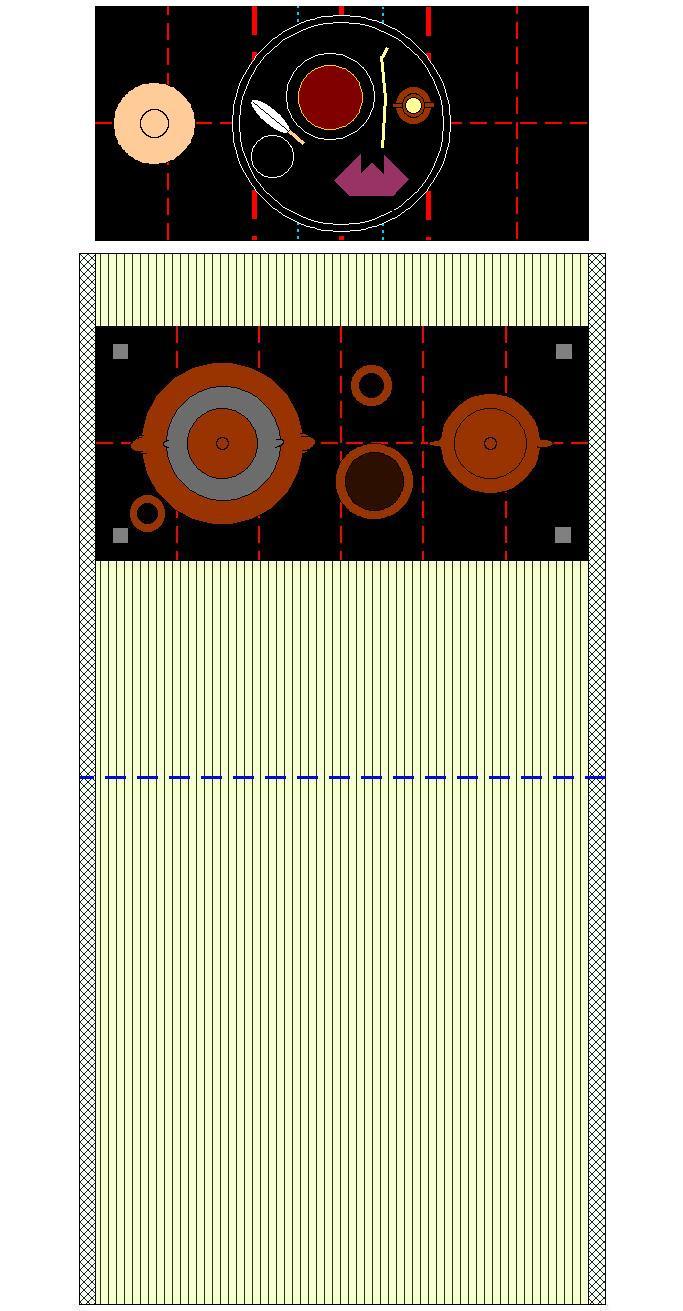
The habōki and fukusa gather the dai-temmoku, chashaku, and natsume into one group -- indicating that tea will be served from the natsume first*.
The tea in the sasa-mimi will be served later -- though whether as a second variety of koicha, or as usucha, depends on the host and his feelings regarding which kind of service his guests would prefer†. __________ *The basic temae would resemble the same arrangement when the objects were displayed on the shaku-nagabon:
- the kae-chawan would be lowered to the mat first;
- then the fukusa would be picked up, folded, and inserted into the futokoro of the host's kimono;
- then the chashaku would be piced up and lowered to rest across the rim of the kae-chawan;
- then the dai-temmoku would be moved to the ten-ita, to the left of the tray;
- next the natsume would be lowered to the mat, and placed in front of the mizusashi as usual; and then the dai-temmoku lowered and placed beside it;
- then the sasa-mimi would be moved to the center of the tray, and the habōki placed either in front of it, or to its left.
Some see the centering of the sasa-mimi on the dai maru-bon (with the habōki placed either in front of it, or to its left) as following the precedent offered in entry 50 (where a taikai was displayed on either a naka maru-bon or a 1-shaku maru-bon, in this same way), and thereby use this as a way to demonstrate that entries 50 and 51 (along with the 3 “lost” arrangements) were an authentic part of Jōō’s manuscript. However, the inversion of this theory is equally possible: taking this secondary arrangement (which is not even mentioned in the annotation) as a sort of validation, the two entries in question could have been inserted where they were precisely because that would give them credence.
The dai maru-bon would be lowered to the mat when it is time to serve tea with the sasa-mimi (both the dai temmoku and the sasa-mimi will stand on the tray during the preparation of tea); the habōki is used to clean the tray.
†Both the natsume, and the sasa-mimi would be tied in their shifuku.
While, in the modern day, the usucha-ire is usually not tied in a shifuku, in the old days this was not done only when the tea it contained had been used previously (an example being that when Rikyū received guests after serving tea to Hideyoshi, while the utensils were all the same, the tea container was left without its shifuku -- since the tea it contained was what remained from his earlier gathering). When the tea it contained had been freshly ground for this chakai, however, the container of tea intended for usucha was tied in a shifuku as well as that prepared for koicha -- and this had been the precedent since the time of Yoshimasa (who occasionally served three kinds of tea during one session, particularly when cutting open a new cha-tsubo -- two kinds of koicha, and one usucha, representing the three varieties of tea typically sealed in each jar).
4 notes
·
View notes